3RD TERM
3RD TERM
SCHEME OF WORK
WEEKS TOPICS
1. Non-Living Things
- Examples of non-living things
- Classification of; Metals, Non-metals
- Properties, uses and importance of Non-living matter.
2. Gravitation and Weightlessness
- Meaning of gravitation
- Weightlessness
- Effects of gravitation on objects.
3. Space Travel
- Meaning of space travel.
- Purpose of space travel.
4. Benefits and Dangers of Space travels.
5. Satellite
- Meaning of Satellite
- Uses
- Communication
- Photography
- Mapping, etc.
- Geographical Information System (GIS)
6. Energy
- Meaning of energy.
- Sources of energy.
- Forms of energy.
7. Transfer of Energy
- Uses of energy.
8. Renewable and Non-renewable Energy
- Meaning
- Examples
- Use and misuse
9. Energy and society.
10. Forces.
- Concept of force.
- Types of forces
- Contact and non-contact forces, magnetic and gravitational forces.
11. Calculation of Gravitational Forces
- Balanced and unbalanced forces.
- Friction: uses, advantages and disadvantages.
12. Revision
WEEKS TOPICS
1. Non-Living Things
- Examples of non-living things
- Classification of; Metals, Non-metals
- Properties, uses and importance of Non-living matter.
2. Gravitation and Weightlessness
- Meaning of gravitation
- Weightlessness
- Effects of gravitation on objects.
3. Space Travel
- Meaning of space travel.
- Purpose of space travel.
4. Benefits and Dangers of Space travels.
5. Satellite
- Meaning of Satellite
- Uses
- Communication
- Photography
- Mapping, etc.
- Geographical Information System (GIS)
6. Energy
- Meaning of energy.
- Sources of energy.
- Forms of energy.
7. Transfer of Energy
- Uses of energy.
8. Renewable and Non-renewable Energy
- Meaning
- Examples
- Use and misuse
9. Energy and society.
10. Forces.
- Concept of force.
- Types of forces
- Contact and non-contact forces, magnetic and gravitational forces.
11. Calculation of Gravitational Forces
- Balanced and unbalanced forces.
- Friction: uses, advantages and disadvantages.
12. Revision
WEEK 1
TOPIC: NON LIVING THINGS
CONTENT : 1. Examples of non living things; Classification of metals
non metals; Properties of metals and non metals
2. Uses and importance of non living matter
Sub-Topic 1: EXAMPLES OF NON-LIVING THINGS:
Matter is anything that has weight and occupies space. Matter can be classified into living and non-living things.
Examples of non-living things: many of them could be metals or non-metals.
Metals: examples are copper, iron rod, empty cans, aluminum
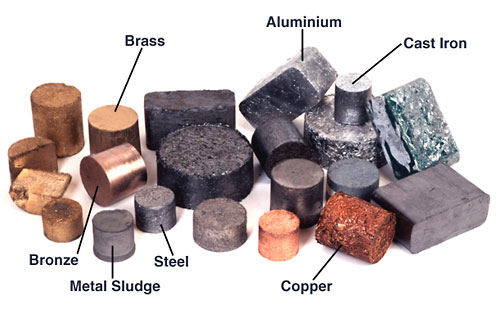
Non-metals: examples are plastic, paper, cloth, wood, rubber, sulphur, nitrogen, air, thread, carbon black and diamond.
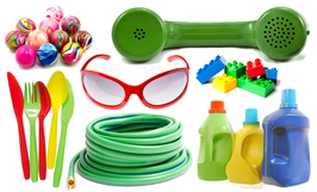
Classification of metals and non-metals:
Metals has many characteristics which distinguish or differentiate them from non-metals
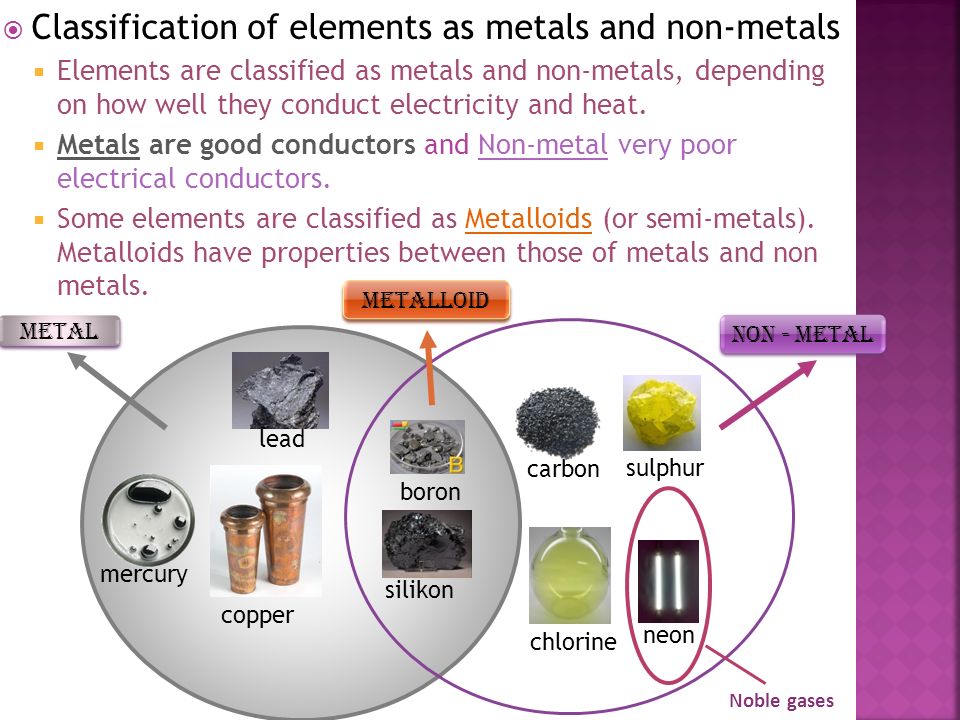
Classification\ properties of metals and non-metals
S/No Metals Non-metals
1. Metals are hard Non-metals are soft except diamond
2. Metals can be beaten or hammered into thin sheet i.e. they are malleable Non-metals cannot be hammered i.e. they are brittle
3. Metals are shiny and can be polished i.e. they have metallic lucre Non-metals are not shiny i.e. they have on metallic lucre
4. Metals can be drawn into wires i.e. they are ductile They cannot be drawn into wire
5. Metals are heavy in weight i.e. they have high density Non-metals are light i.e. they have low density
6. Metals are good conductors of heat Non-metals are poor conductors of heat.
7. Metals are good conductors of electricity Non-metals are poor conductors of electricity.
8. Metals can rust Non-metals do not rust
9. Metals generally have a high melting point Non-metals have a lower melting point.
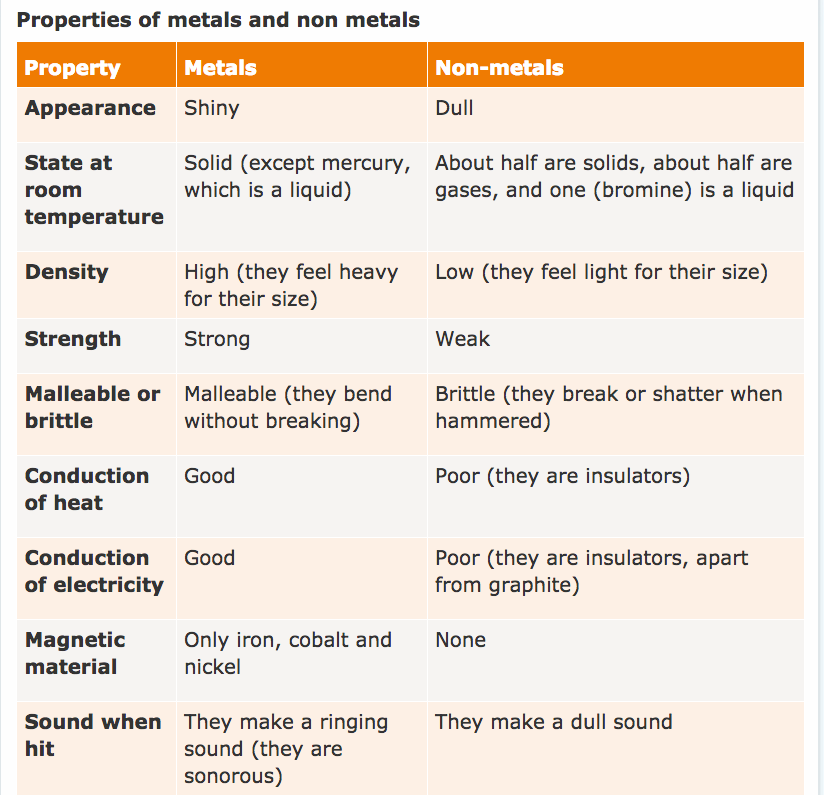
Evaluation:
1. Classify the following based on their physical appearance into metals non-metals. Iron, copper, diamond, wood, glass, zinc, carbon, sulphur, paper and Steel.
2. State five properties each of non-metals and metals
Sub-Topic 2: Uses of metals and non-metals
Uses of metals
1. Manufacture of motors vehicles and aero planes
2. For building houses, bridges and water tanks.
3. For construction of ships, roofing sheets and refrigerators.
4. Copper, iron, aluminum, silver, gold e.t.c. can be drawn into wire and used in production of cutleries (e.g. Spoons, Knives, Fork), machetes, hoes, diggers, ornaments (rings, bracelets).
5. For making cooking utensils.
Uses of non-metals
1. Roofing of houses e.g. asbestos, planks
2. Use as insulator for electrical appliances. Help to protect against shock e.g. handle of knife, screwdriver, and rubber for covering flexible wires.
3. For decoration of houses and buildings, furniture (e.g. tables, chairs) etc.
4. Oxygen is used for respiration
5. Carbon is used in torch light batteries
6. Sulphur is used in medicine
7. Chlorine is used for purifying water.
Evaluation:
1. What is matter?
2. Matter can be classified into what? Name them.
3. State the uses of metals and non-metals.
Reading assignment:
Teacher to give assignment from current textbook.
Assignment:
1. State three chemical differences between metal and non-metal.
2. Write five properties of metals.
MAIN TOPIC: Non-living things
SPECIFIC TOPIC: Classification of Non living things
REFERENCE BOOK:
a. Nigerian Basic Science project pupils textbook one by STAN
b. Exam focus, integrated science by Adebayo Begun
PERFORMANCE OBJECTIVE: At the end of the lesson the students should be able to:
a. Describe non-living components
b. State the classes of non-living things
CONTENT: Non-living things
Non-living things are things that do not have life. Non living things can be classified according to their properties or characteristics. They may be classified in terms of colour, size, shape, smell, taste and texture. All non-living things are made of matter. Matters can also be grouped in terms of their state that is solid, liquid and gas.
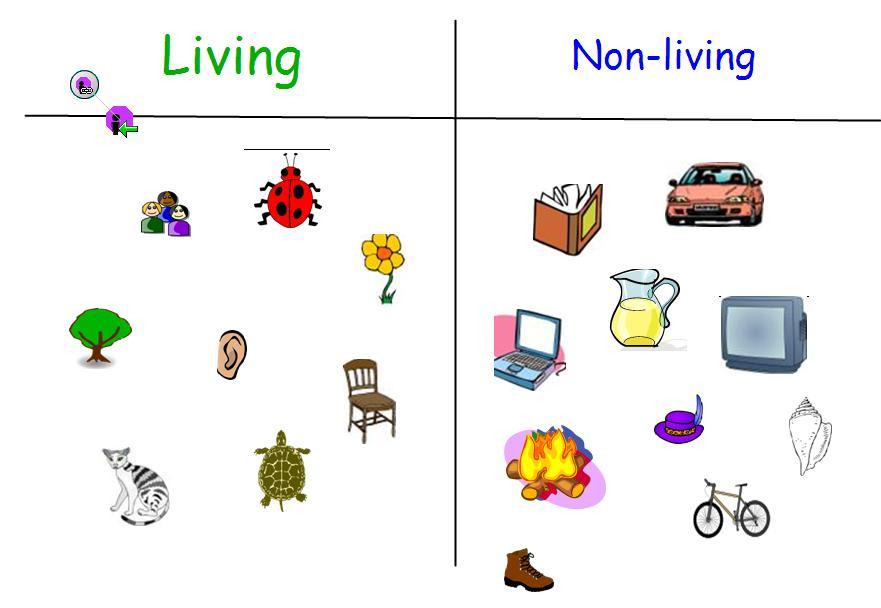
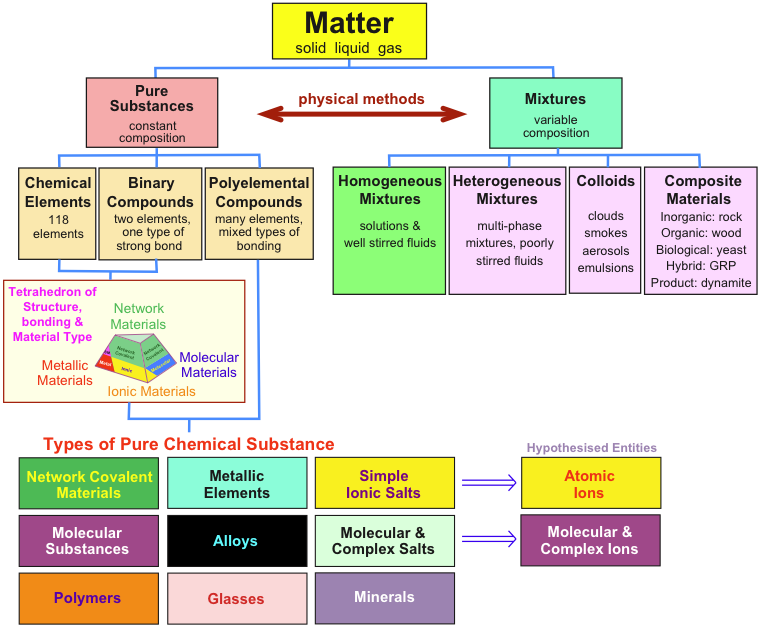
Classification of substances into state, colour, odour, and taste.
Substance.........State...........Colour.................Odour...............Taste
Air.....................Gas..............Colourless...........Odourless..........-
Chlorine............Gas..............Greenish yellow...Irritating............-
Water...............Liquid...........Colourless...........Odourless..........-
Lime juice.........Liquid...........Yellowish.............Fruity smell........Sour
Sulphur............Solid.............Yellow.................Pungent smell.....-
Sand................Solid.............Brown.....................-......................-
EVALUATION
a. Describe non-living things
b. Mention the classes of non-living things
further studies
http://schooltutoring.com/help/classifi ... ng-things/
http://www.glogster.com/umairah/classif ... _view=True
http://www.tutorvista.com/biology/chara ... ing-things#
http://resources.edb.gov.hk/~s1sci/R_S1 ... le-cot.htm
LESSON 55
MAIN TOPIC : Plants and Animals
SUB -TOPIC : Examples and characteristics of plants and animals
REFERENCE BK : Integrated Science for Nigerian Junior Secondary School Book 1 by F O C Ndu, L O Nd
PERFORMANCE OBJECTIVE : At the end of the lesson student should be able to
1. State ways in which plants is important to human being
2. Mention uses of animals to human being
CONTENT:
EXAMPLES OF PLANTS ARE:-
Carpet grass, Pride of Barbados, Mango tree, Orange tree, Elephant grass, Hibiscus flower, Yellow bush
EXAMPLES OF ANIMALS ARE:-
Sheep, Cow, Rat, Elephant, Grasshopper, Snake, Horse, Sea lion, Monkey, Mouse, Giraffe, Dog, Goat
Characteristics of Plants
1. Plants manufacture their own food through photosynthesis which are called autotrophic
2. Plants have no complex organs for excretion
3. They do not move from one place to another but carry out bending movement
4. Plants grow in length only at the tips of the stems and roots
5. There is no courtship in reproduction
6. Respond to plants is slow only sensitive plants
7. Plants do not have organs for breathing.
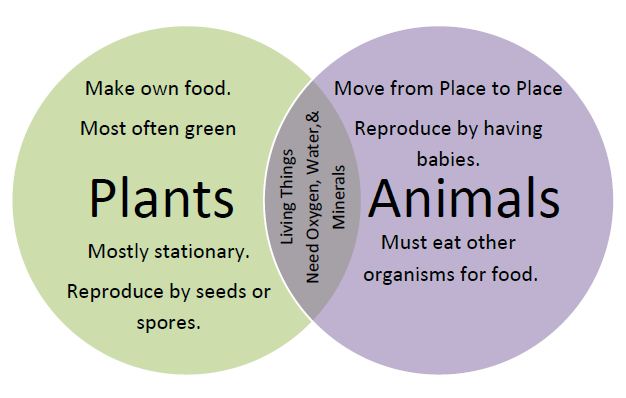
Characteristics of animals
1. Animals move from place to place their own
2. They breathe through complex organs such as lungs and gills
3. They have a complex for excretion
4. They feed on plants or other animals so they are called heterotrophic
5. Growth occurs in all parts of the animals.
6. They respond quickly to changes in the environment.
7. There is usually courtship in reproduction.
EVALUATION / CLASSWORK :
1. Name two examples of plants and animals each besides the one we have mentioned in the class
2. State the characteristics of plants
3. Mention the characteristics of animal
ASSIGNMENT:
1. State uses/importance of the plants
2. Mention uses / importance of the animals
further studies
http://www.learnnext.com/lesson/CBSE-VI ... Things.htm
http://www.buzzle.com/articles/characte ... hings.html
http://www.sciencekids.co.nz/gamesactiv ... imals.html
http://www.cliffsnotes.com/study_guide/ ... -8578.html
practice test
http://www.funtrivia.com/playquiz/quiz139033fec8c0.html
http://www.funtrivia.com/newflash/trivia.cfm?qid=139033
CONTENT : 1. Examples of non living things; Classification of metals
non metals; Properties of metals and non metals
2. Uses and importance of non living matter
Sub-Topic 1: EXAMPLES OF NON-LIVING THINGS:
Matter is anything that has weight and occupies space. Matter can be classified into living and non-living things.
Examples of non-living things: many of them could be metals or non-metals.
Metals: examples are copper, iron rod, empty cans, aluminum

Non-metals: examples are plastic, paper, cloth, wood, rubber, sulphur, nitrogen, air, thread, carbon black and diamond.

Classification of metals and non-metals:
Metals has many characteristics which distinguish or differentiate them from non-metals

Classification\ properties of metals and non-metals
S/No Metals Non-metals
1. Metals are hard Non-metals are soft except diamond
2. Metals can be beaten or hammered into thin sheet i.e. they are malleable Non-metals cannot be hammered i.e. they are brittle
3. Metals are shiny and can be polished i.e. they have metallic lucre Non-metals are not shiny i.e. they have on metallic lucre
4. Metals can be drawn into wires i.e. they are ductile They cannot be drawn into wire
5. Metals are heavy in weight i.e. they have high density Non-metals are light i.e. they have low density
6. Metals are good conductors of heat Non-metals are poor conductors of heat.
7. Metals are good conductors of electricity Non-metals are poor conductors of electricity.
8. Metals can rust Non-metals do not rust
9. Metals generally have a high melting point Non-metals have a lower melting point.

Evaluation:
1. Classify the following based on their physical appearance into metals non-metals. Iron, copper, diamond, wood, glass, zinc, carbon, sulphur, paper and Steel.
2. State five properties each of non-metals and metals
Sub-Topic 2: Uses of metals and non-metals
Uses of metals
1. Manufacture of motors vehicles and aero planes
2. For building houses, bridges and water tanks.
3. For construction of ships, roofing sheets and refrigerators.
4. Copper, iron, aluminum, silver, gold e.t.c. can be drawn into wire and used in production of cutleries (e.g. Spoons, Knives, Fork), machetes, hoes, diggers, ornaments (rings, bracelets).
5. For making cooking utensils.
Uses of non-metals
1. Roofing of houses e.g. asbestos, planks
2. Use as insulator for electrical appliances. Help to protect against shock e.g. handle of knife, screwdriver, and rubber for covering flexible wires.
3. For decoration of houses and buildings, furniture (e.g. tables, chairs) etc.
4. Oxygen is used for respiration
5. Carbon is used in torch light batteries
6. Sulphur is used in medicine
7. Chlorine is used for purifying water.
Evaluation:
1. What is matter?
2. Matter can be classified into what? Name them.
3. State the uses of metals and non-metals.
Reading assignment:
Teacher to give assignment from current textbook.
Assignment:
1. State three chemical differences between metal and non-metal.
2. Write five properties of metals.
MAIN TOPIC: Non-living things
SPECIFIC TOPIC: Classification of Non living things
REFERENCE BOOK:
a. Nigerian Basic Science project pupils textbook one by STAN
b. Exam focus, integrated science by Adebayo Begun
PERFORMANCE OBJECTIVE: At the end of the lesson the students should be able to:
a. Describe non-living components
b. State the classes of non-living things
CONTENT: Non-living things
Non-living things are things that do not have life. Non living things can be classified according to their properties or characteristics. They may be classified in terms of colour, size, shape, smell, taste and texture. All non-living things are made of matter. Matters can also be grouped in terms of their state that is solid, liquid and gas.


Classification of substances into state, colour, odour, and taste.
Substance.........State...........Colour.................Odour...............Taste
Air.....................Gas..............Colourless...........Odourless..........-
Chlorine............Gas..............Greenish yellow...Irritating............-
Water...............Liquid...........Colourless...........Odourless..........-
Lime juice.........Liquid...........Yellowish.............Fruity smell........Sour
Sulphur............Solid.............Yellow.................Pungent smell.....-
Sand................Solid.............Brown.....................-......................-
EVALUATION
a. Describe non-living things
b. Mention the classes of non-living things
further studies
http://schooltutoring.com/help/classifi ... ng-things/
http://www.glogster.com/umairah/classif ... _view=True
http://www.tutorvista.com/biology/chara ... ing-things#
http://resources.edb.gov.hk/~s1sci/R_S1 ... le-cot.htm
LESSON 55
MAIN TOPIC : Plants and Animals
SUB -TOPIC : Examples and characteristics of plants and animals
REFERENCE BK : Integrated Science for Nigerian Junior Secondary School Book 1 by F O C Ndu, L O Nd
PERFORMANCE OBJECTIVE : At the end of the lesson student should be able to
1. State ways in which plants is important to human being
2. Mention uses of animals to human being
CONTENT:
EXAMPLES OF PLANTS ARE:-
Carpet grass, Pride of Barbados, Mango tree, Orange tree, Elephant grass, Hibiscus flower, Yellow bush
EXAMPLES OF ANIMALS ARE:-
Sheep, Cow, Rat, Elephant, Grasshopper, Snake, Horse, Sea lion, Monkey, Mouse, Giraffe, Dog, Goat
Characteristics of Plants
1. Plants manufacture their own food through photosynthesis which are called autotrophic
2. Plants have no complex organs for excretion
3. They do not move from one place to another but carry out bending movement
4. Plants grow in length only at the tips of the stems and roots
5. There is no courtship in reproduction
6. Respond to plants is slow only sensitive plants
7. Plants do not have organs for breathing.

Characteristics of animals
1. Animals move from place to place their own
2. They breathe through complex organs such as lungs and gills
3. They have a complex for excretion
4. They feed on plants or other animals so they are called heterotrophic
5. Growth occurs in all parts of the animals.
6. They respond quickly to changes in the environment.
7. There is usually courtship in reproduction.
EVALUATION / CLASSWORK :
1. Name two examples of plants and animals each besides the one we have mentioned in the class
2. State the characteristics of plants
3. Mention the characteristics of animal
ASSIGNMENT:
1. State uses/importance of the plants
2. Mention uses / importance of the animals
further studies
http://www.learnnext.com/lesson/CBSE-VI ... Things.htm
http://www.buzzle.com/articles/characte ... hings.html
http://www.sciencekids.co.nz/gamesactiv ... imals.html
http://www.cliffsnotes.com/study_guide/ ... -8578.html
practice test
http://www.funtrivia.com/playquiz/quiz139033fec8c0.html
http://www.funtrivia.com/newflash/trivia.cfm?qid=139033
WEEK 2
SUB TOPIC : Types of living things and purpose of living things
REFERENCE BK : Integrated Science for Nigerian Junior Secondary School Book 1 FOC Ndu , LO Ndu
PERFORMANCE OBJECTIVE : At the end of the end of the lesson the students should be able to
State the types of activities of living things
State the purpose of feeding, sensitivity
CONTENT: - TYPES OF ACTIVITIES OF LIVING THINGS
Living things do seven things. These are listed and explain below.
MOVEMENT:- Movement is a change in position. There are different kinds of movement
1. Active movement :- occurs when a living thing moves by its own energy.
2.Passive movement:- occurs when a living thing is carried by wind.
3. Bending movement:- occurs in plants which bend towards light water or gravity.

RESPIRATION:- Respiration is made of two parts. One part of respiration is breathing. It involves taking air in and out of the body. The other part is use of oxygen in the which reacts with digested food substances in the body.
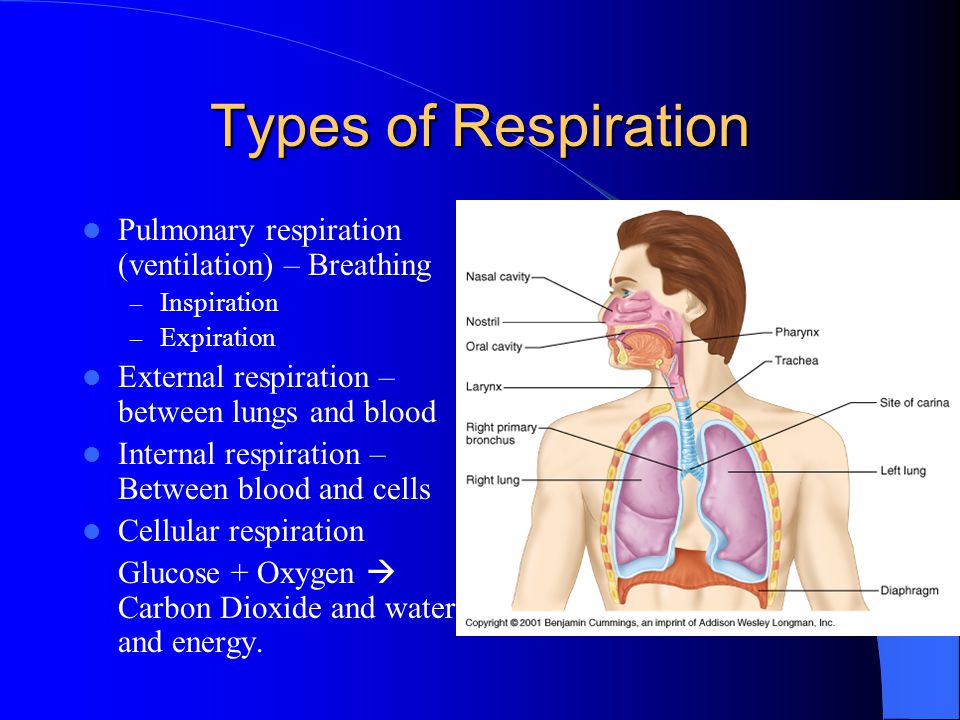
EXCRETION:- is the removal of waste products of the body. It is the removal of waste products formed mainly from respiration e.g sweat, urea
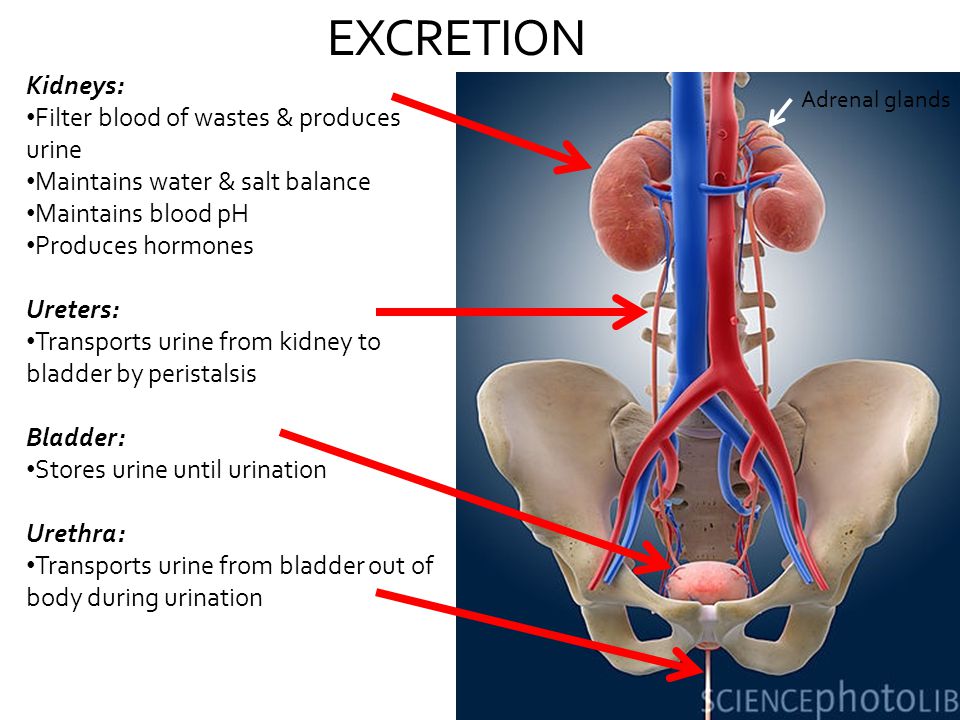
GROWTH:- It involves increase in size, as a result of formation of new cells and increase in the size of new
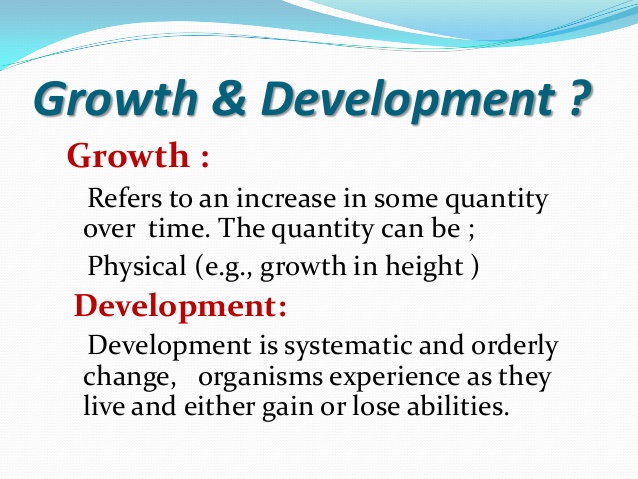
SENSITIVITY:- Ability to respond to changes in environment.

REPRODUCTION:- Is the production of new individuals of the same type
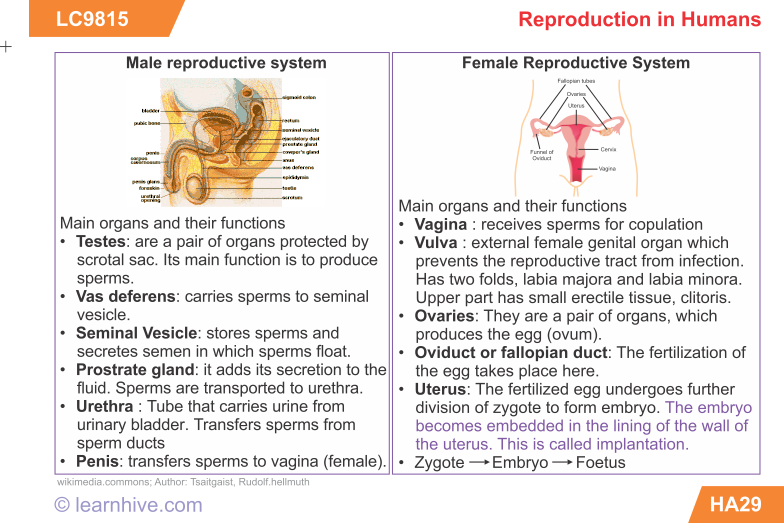
PURPOSE OF MOVEMENT
1. To obtain food
2. To avoid bad weather
3. To respond to changes in the environment
4. To escape from enemies or danger
5. To seek reproductive mates
PURPOSE OF FEEDING
1. The purpose of feeding is to obtain energy from food
PURPOSE OF RESPIRATION
1. To take oxygen of the air into the body of the living things by breathing
2. To use the oxygen taken into the body to break down food in the body to release energy
PURPOSE OF EXCRETION
1. Waste products are harmful to the body. The purpose of excretion is to removed
all harmful waste products which if not removed, will cause death.
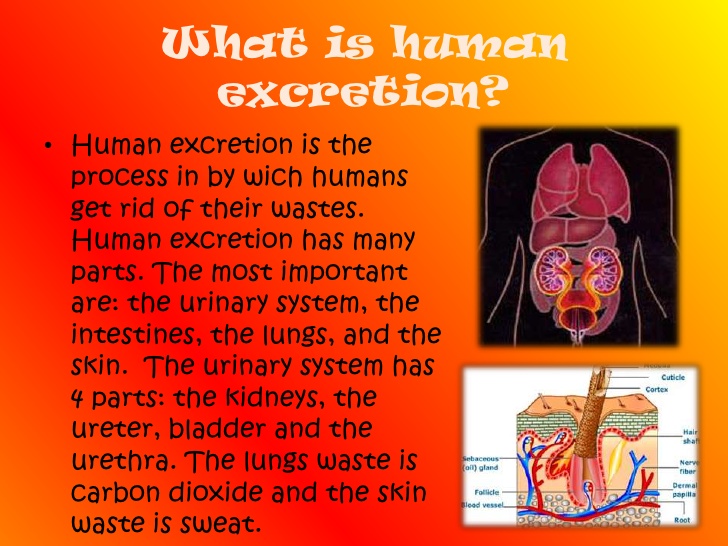
PURPOSE OF GROWTH
Young, small organisms cannot reproduce . They have to grow and develop before they can reproduce. For instance, a young girl of 6 years cannot be a mother . She must grow in size and she must develop parts of her body which will enable she to be successfully give birth to a baby
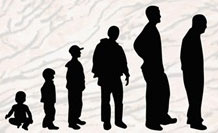
PURPOSE OF SENSITIVITY
1. Sense organs help us to obtain information about changes in our environment
2. Sense organs help us to protect ourselves from harm.
3. Sense organs help us to live successfully and work in our environment
4. Sense organs help to enjoy flowers, music, painting, TV programmes
5.
PURPOSE OF REPRODUCTION
The purpose of reproduction is to increase in number so that each living thing will preserve its own
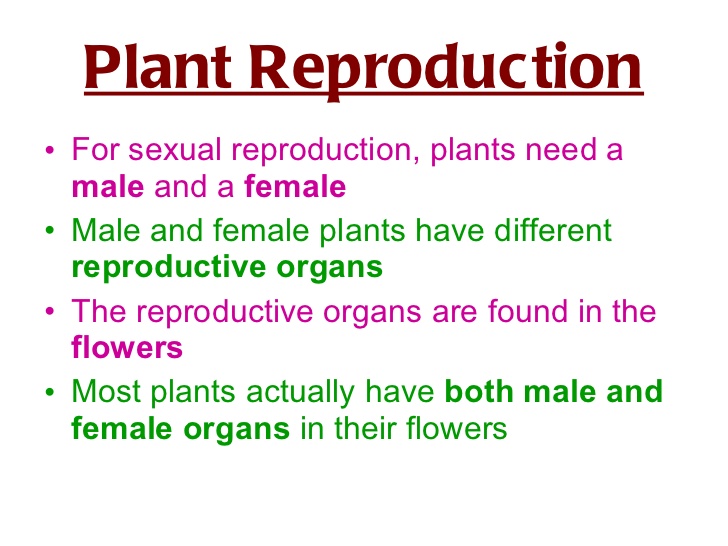
EVALUATION / CLASSWORK :
1. State the characteristics of living things
2. State what each letter stands for in MR NIGER D
ASSIGNMENT:
1. State the organs of movement in human beings, birds, reptiles, toads; insects
further studies
http://classroom.jc-schools.net/sci-uni ... things.htm
practice test
http://www.softschools.com/quizzes/scie ... iz874.html
http://wikis.engrade.com/lifefunctionspracticequi
TOPIC: GRAVITATION AND WEIGHTLESSNESS
Content: 1. Meaning of gravitation
2. Weightlessness and Effects of gravitation on objects
Sub-Topic 1: Meaning of gravitation:
Gravitational force is a type of force that acts on a body across a distance, without any contact between the source and the body.

The earth exerts a gravitational force on bodies by which it pulls these bodies towards itself. This is why fruits fall to the ground from the tree and do not rise upwards. Also, when a stone is thrown upwards it soon stops its upward movement and starts to fall back to the earth.
The force of gravity is a universal force. It exists between the earth and bodies and between planets and stars.
Gravity: is the force with which the earth attracts objects towards its centre. Gravitational pull comes from the concept of gravity. The earth’s gravitational pull is a downward force pulling objects towards the centre of the earth.
The amount of force with which gravity pulls an object depends on three things:
i. The mass of the object.
ii. The mass of the earth.
iii. The distance between the centre of the object and the earth.
Evaluation:
1. What is gravitational force?
2. What is gravity?
3. What makes a stone thrown upward to come down?
[youtube]https://youtu.be/A5fBgmo1V3k[/youtube]
Sub-Topic 2: Weightlessness and Effects of gravitation on objects
Weightlessness:
The term weightlessness is a feeling of being weightless. It does not mean that you do not have weight but you will just feel as if you are weightless.
What is weight? Weight is a force exerted by the earth on a body.

Weightless in Space
Earth’s gravity is what keeps us from flying off into space. Astronauts in orbit don't feel the effects of gravity. This condition is called weightlessness.

Effect of gravitation on objects:
1. Gravitation gives objects weight.
2. Gravitation keeps the earth and the other planet in their orbits around the sun.
3. Gravitation keeps the moon in its orbits around the earth.
4. Gravitation keeps the moon in its path in the sky.
5. It is the work against gravity that make aero plane to fly in the sky.
6. Gravitation bring about the formation of tides, for convection (by which hot fluids rise)
Evaluation:
1. What is weight?
2. Explain weightlessness
3. What is the effect of gravitational pull on an object?
4. The amount of force of gravity on an object depends on what?
Reading Assignment:
Stan pages 131-132 and basic science made easy by F.I. Kehinde pages 93-97. (Use current Textbook)
Assignment:
1. Define gravitational pull.
2. Mention the three factors by which the amount of force with which pulls an object depends.
[youtube]https://youtu.be/XHL1opjFR7Y[/youtube]
REFERENCE BK : Integrated Science for Nigerian Junior Secondary School Book 1 FOC Ndu , LO Ndu
PERFORMANCE OBJECTIVE : At the end of the end of the lesson the students should be able to
State the types of activities of living things
State the purpose of feeding, sensitivity
CONTENT: - TYPES OF ACTIVITIES OF LIVING THINGS
Living things do seven things. These are listed and explain below.
MOVEMENT:- Movement is a change in position. There are different kinds of movement
1. Active movement :- occurs when a living thing moves by its own energy.
2.Passive movement:- occurs when a living thing is carried by wind.
3. Bending movement:- occurs in plants which bend towards light water or gravity.

RESPIRATION:- Respiration is made of two parts. One part of respiration is breathing. It involves taking air in and out of the body. The other part is use of oxygen in the which reacts with digested food substances in the body.

EXCRETION:- is the removal of waste products of the body. It is the removal of waste products formed mainly from respiration e.g sweat, urea

GROWTH:- It involves increase in size, as a result of formation of new cells and increase in the size of new

SENSITIVITY:- Ability to respond to changes in environment.

REPRODUCTION:- Is the production of new individuals of the same type

PURPOSE OF MOVEMENT
1. To obtain food
2. To avoid bad weather
3. To respond to changes in the environment
4. To escape from enemies or danger
5. To seek reproductive mates
PURPOSE OF FEEDING
1. The purpose of feeding is to obtain energy from food
PURPOSE OF RESPIRATION
1. To take oxygen of the air into the body of the living things by breathing
2. To use the oxygen taken into the body to break down food in the body to release energy
PURPOSE OF EXCRETION
1. Waste products are harmful to the body. The purpose of excretion is to removed
all harmful waste products which if not removed, will cause death.

PURPOSE OF GROWTH
Young, small organisms cannot reproduce . They have to grow and develop before they can reproduce. For instance, a young girl of 6 years cannot be a mother . She must grow in size and she must develop parts of her body which will enable she to be successfully give birth to a baby

PURPOSE OF SENSITIVITY
1. Sense organs help us to obtain information about changes in our environment
2. Sense organs help us to protect ourselves from harm.
3. Sense organs help us to live successfully and work in our environment
4. Sense organs help to enjoy flowers, music, painting, TV programmes
5.
PURPOSE OF REPRODUCTION
The purpose of reproduction is to increase in number so that each living thing will preserve its own

EVALUATION / CLASSWORK :
1. State the characteristics of living things
2. State what each letter stands for in MR NIGER D
ASSIGNMENT:
1. State the organs of movement in human beings, birds, reptiles, toads; insects
further studies
http://classroom.jc-schools.net/sci-uni ... things.htm
practice test
http://www.softschools.com/quizzes/scie ... iz874.html
http://wikis.engrade.com/lifefunctionspracticequi
TOPIC: GRAVITATION AND WEIGHTLESSNESS
Content: 1. Meaning of gravitation
2. Weightlessness and Effects of gravitation on objects
Sub-Topic 1: Meaning of gravitation:
Gravitational force is a type of force that acts on a body across a distance, without any contact between the source and the body.

The earth exerts a gravitational force on bodies by which it pulls these bodies towards itself. This is why fruits fall to the ground from the tree and do not rise upwards. Also, when a stone is thrown upwards it soon stops its upward movement and starts to fall back to the earth.
The force of gravity is a universal force. It exists between the earth and bodies and between planets and stars.
Gravity: is the force with which the earth attracts objects towards its centre. Gravitational pull comes from the concept of gravity. The earth’s gravitational pull is a downward force pulling objects towards the centre of the earth.
The amount of force with which gravity pulls an object depends on three things:
i. The mass of the object.
ii. The mass of the earth.
iii. The distance between the centre of the object and the earth.
Evaluation:
1. What is gravitational force?
2. What is gravity?
3. What makes a stone thrown upward to come down?
[youtube]https://youtu.be/A5fBgmo1V3k[/youtube]
Sub-Topic 2: Weightlessness and Effects of gravitation on objects
Weightlessness:
The term weightlessness is a feeling of being weightless. It does not mean that you do not have weight but you will just feel as if you are weightless.
What is weight? Weight is a force exerted by the earth on a body.

Weightless in Space
Earth’s gravity is what keeps us from flying off into space. Astronauts in orbit don't feel the effects of gravity. This condition is called weightlessness.

Effect of gravitation on objects:
1. Gravitation gives objects weight.
2. Gravitation keeps the earth and the other planet in their orbits around the sun.
3. Gravitation keeps the moon in its orbits around the earth.
4. Gravitation keeps the moon in its path in the sky.
5. It is the work against gravity that make aero plane to fly in the sky.
6. Gravitation bring about the formation of tides, for convection (by which hot fluids rise)
Evaluation:
1. What is weight?
2. Explain weightlessness
3. What is the effect of gravitational pull on an object?
4. The amount of force of gravity on an object depends on what?
Reading Assignment:
Stan pages 131-132 and basic science made easy by F.I. Kehinde pages 93-97. (Use current Textbook)
Assignment:
1. Define gravitational pull.
2. Mention the three factors by which the amount of force with which pulls an object depends.
[youtube]https://youtu.be/XHL1opjFR7Y[/youtube]
WEEK 3
TOPIC: SPACE TRAVEL
CONTENT: 1. The Meaning of Space travel.
2. Purpose of space travel.
Sub-Topic 1: The meaning of space travel:
Space is the environment surrounding the earth, moon and other planets.
Human beings are able to go to space and spend days and months using a space rocket called space shuttle. Space travels are expensive to run.
On 21st July 1969 Neil Armstrong an American was the first person to step on the moon. He was followed by Edwin Aldrin, also 2 other Americans, Eugene Cernan and Harrison Schmitt who stayed for about 74 hours and 59 minutes on the moon surface.
Space travel is traveling from the earth to outer space.
A satellite is a natural body that revolves round a planet. The earth is a planet and has one satellite which is the moon that revolves round the earth.

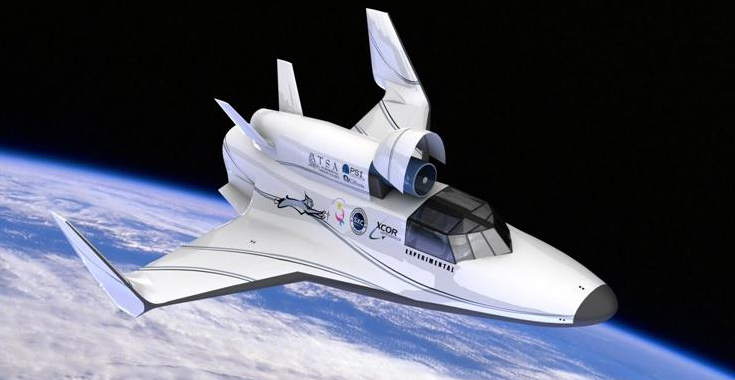
Space Travel
For hundreds of years, people dreamed about traveling to outer space. The invention of huge rockets made space travel a reality. An astronaut first went into space in 1961 (A Russian, Major Yuri Gagarin). Only eight years later, astronauts landed on the Moon. Since then, people have continued to explore space.

Rocketing to Space
The development of high-powered rockets, such as this Saturn V rocket, allowed human beings to travel to outer space. Saturn V rockets are the largest rockets ever built.
Evaluation:
1. What is a space?
2. Who was the first Astronaut in space?
3. Name the first man on the moon.
[youtube]https://youtu.be/pUDa0GOkkWQ[/youtube]
Sub-Topic 2: Purpose of Space Travel
The main purpose of space travel is to gain more knowledge that may be useful to human beings. Other purposes include:
i. Advancing scientific research.
ii. Uniting different nations.
iii. Ensuring the future survival of humanity
iv. Developing strategic military advantages over other nations.
Evaluation:
1. What is a satellite?
2. Enumerate 4 purposes of space travel.
ASSIGNMENT
1. Define space travel
2. Mention two dangers of space travel
Further Studies
BENEFITS AND DANGERS OF SPACE TRAVELS
Benefits
1. Satellites launched have provided useful information about other planets.
2. It helps the scientist to discover other planets like Mercury, Venus, Mars, and Jupiter.
3. Experiment shows that protein form more perfectly in space than they do on earth. This makes space proteins suitable for design and testing of new medicines.
4. Help in communication.
5. It aids gathering of scientific information about the earth and other planets
Dangers
1. The major danger is that man cannot live permanently in the space.
2. Human beings who stay in space for long periods develop weak bones due to loss of calcium.
3. Space travel is risky. It may lead to loss of life e.g. The disappearance of the American Space Flight named Avenger with 11 crew members in 1980.
EVALUATION
1. What are the dangers of space travel?
2. State the advantages of space travel.
WEEKEND ASSIGNMENT
Read Satellite and write short notes on it.
[youtube]https://youtu.be/fX8g3wcUY5I[/youtube]
SPECIFIC TOPIC: Space travel
REFERENCE BOOK: Nigerian Basic Science Project. Project Textbook 1 by STAN
PERFORMANCE OBJECTIVE: At the end of the lesson the students should be able to:
a. Mention the first man in space
b. Mention the first man to land successfully on the moon
c. State the advantages of space travel.
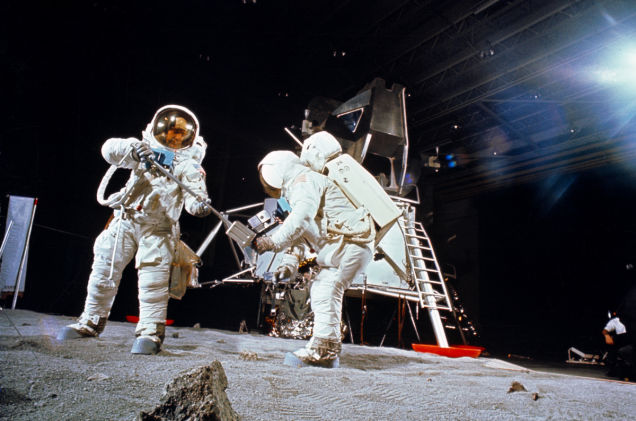
CONTENT: Space Travel
Astronaut are the scientists when travels to the space. Astronauts travels to the space perform various experiments, modern astronauts can stay as long as six months in space.
The first man to go to space was a Russian named Yuri Gagarin in April 1961. He orbited round the earth for 108mins.
On 21st July 1969 NEIC ARMSTRONG. An American became the first human being to step on the moon. He was followed on the same day by another America, Edwin Aldrin. They stayed on the moon for 21 hours 36mins.
MEANING OF SPACE TRAVEL
Space travel simply means going to the moon or or planets orbiting the earth in a special craft called spaceship. It is the travel from the earth, through space, to other planets or earth's moon. Outer space is an area that surrounds the sun, the stars, the earth and other planets and their moons.The earth is the only planet to support human life.The light from the stars travels at a special of 299,400km per second.
The ray from the sun takes about 8 minutes to reach the earth. The earth with a diameter of 12,700km is about 149million km from the sun. Light from moons takes only one second to reach us on earth.The sun and all the planets with their moon remain suspended in space, with each keeping to its position, because of the mutual attraction that exist among them. The light which reaches the earth, come from the sun and the stars. The sky on a bright night seems to be with stars. The stars are far bigger than the earth on which we live. Some of the stars have been estimated to be many million times the size of the earth.
CHARACTERISTICS OF OUTER SPACE
1. Light from the sun passes through the outer space
2. There is no force of gravity in outer space
3. The outer space is empty and void
4. Sound does not pass through the outer space

PURPOSE OF SPACE TRAVEL
The purpose of space travel is to obtain scientific information about the moon, planets in our solar system and stars. The importance of space travel to man is immense for instance many technological advances have been made in the course of these space travels, particularly in the fields of radio and television communications.
More is now known by man about space temperature, magnetic fields of the sun and the earth, the amount and kinds of radiation,as well the shape of the earth.

Advantages of space for research
1. Photographs are taken in the space for research purposes
2. Placing of communication satellite in space make phone calls to be cheaper, easier and faster.
Advantages of space travel
a. Space travel enable us to know more about planets, the other celestial bodies
b. Space travel enables us to appreciate the change in climate and weather
c. Space travel enable us to get photograph of the earth which gives room to map
Disadvantages of space travel.
a. It is expensive
b. It is not easy
c. It can disrupt the work of nature
BENEFITS OF SPACE TRAVEL
The main advantages of space travel is the collection of scientific information about the earth and other planets. Other benefits include the production of special :
1. Computers
2. Photographic equipment such as X-ray and gamma-ray machines
3. Telecommunication equipment
4. Remote sensing equipment to guide air craft or spacecraft
DANGERS OF SPACE TRAVEL
Space travel is risky. If any goes wrong, one or more lives will be lost. This can be caused by the following problems
a) Explosion of rockets at the launch pad b) Explosion of rockets in flight
c) Wrong calculation of angles, speed and time of launching
d) Inability of the rockets to reach escape velocity
e) Failure of some necessary equipment in the spaceship to function well

EVALUATION
1. Who are astronauts?
2. Who was the first man in space?
3. State the advantages of space travel.
4. Which country successfully launched into space recently
5. Highlights the disadvantages of space travel
[youtube]https://youtu.be/rpvIX87xrko[/youtube]
further studies
http://science.nationalgeographic.com/s ... ploration/
http://www.wonderrotunda.com/SpaceExploration.php
http://www.ten-facts.com/interesting_fa ... ation.html
practice test
http://curiosity.discovery.com/topic/sp ... -quiz1.htm
http://www.proprofs.com/quiz-school/sto ... ravel-quiz
http://www.funtrivia.com/newflash/trivia.cfm?qid=349924
http://www.funtrivia.com/playquiz/quiz3 ... 0efe8.html
http://www.guardian.co.uk/science/quiz/ ... quiz-space
http://library.thinkquest.org/03oct/015 ... /quiz.html
CONTENT: 1. The Meaning of Space travel.
2. Purpose of space travel.
Sub-Topic 1: The meaning of space travel:
Space is the environment surrounding the earth, moon and other planets.
Human beings are able to go to space and spend days and months using a space rocket called space shuttle. Space travels are expensive to run.
On 21st July 1969 Neil Armstrong an American was the first person to step on the moon. He was followed by Edwin Aldrin, also 2 other Americans, Eugene Cernan and Harrison Schmitt who stayed for about 74 hours and 59 minutes on the moon surface.
Space travel is traveling from the earth to outer space.
A satellite is a natural body that revolves round a planet. The earth is a planet and has one satellite which is the moon that revolves round the earth.


Space Travel
For hundreds of years, people dreamed about traveling to outer space. The invention of huge rockets made space travel a reality. An astronaut first went into space in 1961 (A Russian, Major Yuri Gagarin). Only eight years later, astronauts landed on the Moon. Since then, people have continued to explore space.

Rocketing to Space
The development of high-powered rockets, such as this Saturn V rocket, allowed human beings to travel to outer space. Saturn V rockets are the largest rockets ever built.
Evaluation:
1. What is a space?
2. Who was the first Astronaut in space?
3. Name the first man on the moon.
[youtube]https://youtu.be/pUDa0GOkkWQ[/youtube]
Sub-Topic 2: Purpose of Space Travel
The main purpose of space travel is to gain more knowledge that may be useful to human beings. Other purposes include:
i. Advancing scientific research.
ii. Uniting different nations.
iii. Ensuring the future survival of humanity
iv. Developing strategic military advantages over other nations.
Evaluation:
1. What is a satellite?
2. Enumerate 4 purposes of space travel.
ASSIGNMENT
1. Define space travel
2. Mention two dangers of space travel
Further Studies
BENEFITS AND DANGERS OF SPACE TRAVELS
Benefits
1. Satellites launched have provided useful information about other planets.
2. It helps the scientist to discover other planets like Mercury, Venus, Mars, and Jupiter.
3. Experiment shows that protein form more perfectly in space than they do on earth. This makes space proteins suitable for design and testing of new medicines.
4. Help in communication.
5. It aids gathering of scientific information about the earth and other planets
Dangers
1. The major danger is that man cannot live permanently in the space.
2. Human beings who stay in space for long periods develop weak bones due to loss of calcium.
3. Space travel is risky. It may lead to loss of life e.g. The disappearance of the American Space Flight named Avenger with 11 crew members in 1980.
EVALUATION
1. What are the dangers of space travel?
2. State the advantages of space travel.
WEEKEND ASSIGNMENT
Read Satellite and write short notes on it.
[youtube]https://youtu.be/fX8g3wcUY5I[/youtube]
SPECIFIC TOPIC: Space travel
REFERENCE BOOK: Nigerian Basic Science Project. Project Textbook 1 by STAN
PERFORMANCE OBJECTIVE: At the end of the lesson the students should be able to:
a. Mention the first man in space
b. Mention the first man to land successfully on the moon
c. State the advantages of space travel.

CONTENT: Space Travel
Astronaut are the scientists when travels to the space. Astronauts travels to the space perform various experiments, modern astronauts can stay as long as six months in space.
The first man to go to space was a Russian named Yuri Gagarin in April 1961. He orbited round the earth for 108mins.
On 21st July 1969 NEIC ARMSTRONG. An American became the first human being to step on the moon. He was followed on the same day by another America, Edwin Aldrin. They stayed on the moon for 21 hours 36mins.
MEANING OF SPACE TRAVEL
Space travel simply means going to the moon or or planets orbiting the earth in a special craft called spaceship. It is the travel from the earth, through space, to other planets or earth's moon. Outer space is an area that surrounds the sun, the stars, the earth and other planets and their moons.The earth is the only planet to support human life.The light from the stars travels at a special of 299,400km per second.
The ray from the sun takes about 8 minutes to reach the earth. The earth with a diameter of 12,700km is about 149million km from the sun. Light from moons takes only one second to reach us on earth.The sun and all the planets with their moon remain suspended in space, with each keeping to its position, because of the mutual attraction that exist among them. The light which reaches the earth, come from the sun and the stars. The sky on a bright night seems to be with stars. The stars are far bigger than the earth on which we live. Some of the stars have been estimated to be many million times the size of the earth.
CHARACTERISTICS OF OUTER SPACE
1. Light from the sun passes through the outer space
2. There is no force of gravity in outer space
3. The outer space is empty and void
4. Sound does not pass through the outer space

PURPOSE OF SPACE TRAVEL
The purpose of space travel is to obtain scientific information about the moon, planets in our solar system and stars. The importance of space travel to man is immense for instance many technological advances have been made in the course of these space travels, particularly in the fields of radio and television communications.
More is now known by man about space temperature, magnetic fields of the sun and the earth, the amount and kinds of radiation,as well the shape of the earth.

Advantages of space for research
1. Photographs are taken in the space for research purposes
2. Placing of communication satellite in space make phone calls to be cheaper, easier and faster.
Advantages of space travel
a. Space travel enable us to know more about planets, the other celestial bodies
b. Space travel enables us to appreciate the change in climate and weather
c. Space travel enable us to get photograph of the earth which gives room to map
Disadvantages of space travel.
a. It is expensive
b. It is not easy
c. It can disrupt the work of nature
BENEFITS OF SPACE TRAVEL
The main advantages of space travel is the collection of scientific information about the earth and other planets. Other benefits include the production of special :
1. Computers
2. Photographic equipment such as X-ray and gamma-ray machines
3. Telecommunication equipment
4. Remote sensing equipment to guide air craft or spacecraft
DANGERS OF SPACE TRAVEL
Space travel is risky. If any goes wrong, one or more lives will be lost. This can be caused by the following problems
a) Explosion of rockets at the launch pad b) Explosion of rockets in flight
c) Wrong calculation of angles, speed and time of launching
d) Inability of the rockets to reach escape velocity
e) Failure of some necessary equipment in the spaceship to function well

EVALUATION
1. Who are astronauts?
2. Who was the first man in space?
3. State the advantages of space travel.
4. Which country successfully launched into space recently
5. Highlights the disadvantages of space travel
[youtube]https://youtu.be/rpvIX87xrko[/youtube]
further studies
http://science.nationalgeographic.com/s ... ploration/
http://www.wonderrotunda.com/SpaceExploration.php
http://www.ten-facts.com/interesting_fa ... ation.html
practice test
http://curiosity.discovery.com/topic/sp ... -quiz1.htm
http://www.proprofs.com/quiz-school/sto ... ravel-quiz
http://www.funtrivia.com/newflash/trivia.cfm?qid=349924
http://www.funtrivia.com/playquiz/quiz3 ... 0efe8.html
http://www.guardian.co.uk/science/quiz/ ... quiz-space
http://library.thinkquest.org/03oct/015 ... /quiz.html
WEEK 5
TOPIC: SATELLITE
Content:
1. Meaning of satellite and Uses of satellite
2. Communication, photography, mapping etc. and GeographicalInformation System (GIS).
Sub-Topic 1: Meaning of satellite and uses:
MEANING OF SATELLITE
A satellite is a natural body revolves round a planet. As we have learned earlier, the earth has one satellite which if the moon. Scientist have launched artificial satellites (like space shuttle, rockets etc) into space to carry out experiments, collect information and learn more about other space.
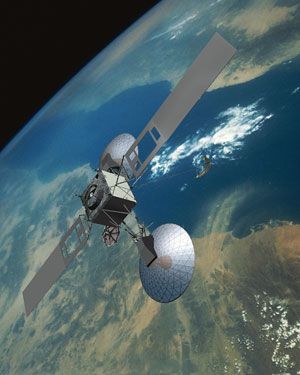
Communications Satellite
Satellites floating in space have made communication over long distances easier and cheaper. A communications satellite receives a signal from Earth and then sends the information—a phone call, fax, or e-mail message—where it’s supposed to go.
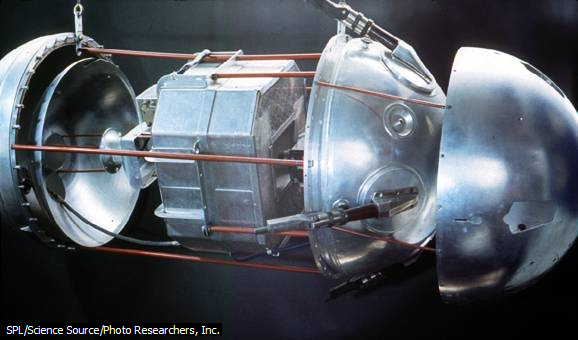
Sputnik 1
The first artificial satellite was Sputnik 1, launched by the Soviet Union in 1957. It orbited Earth about once every 90 minutes for two months before it burned up in the atmosphere.


Weather Satellites
Some satellites are used to gather information about the weather. This satellite photo shows the swirling clouds of Hurricane Mitch, which hit Central America in 1998 and killed more than 11,000 people.
USES OF SATELLITE
1. To gather information
2. For photography (Taking picture of outer space)
3. For mapping
4. For finding location of mineral resources in the ground.
[youtube]https://youtu.be/54MSV2B399o[/youtube]
EVALUATION
1. What are the uses of satellite?
Sub-Topic 2: Communication, Photography, Mapping and Geographic Information System(GIS).
Communication: is an act of discussing with someone or a body in a far or near location.
Photography: It is can be carried out by the use of Photo-camera. It is an act of taking the picture of an object, man, location, town, country and earth at large.
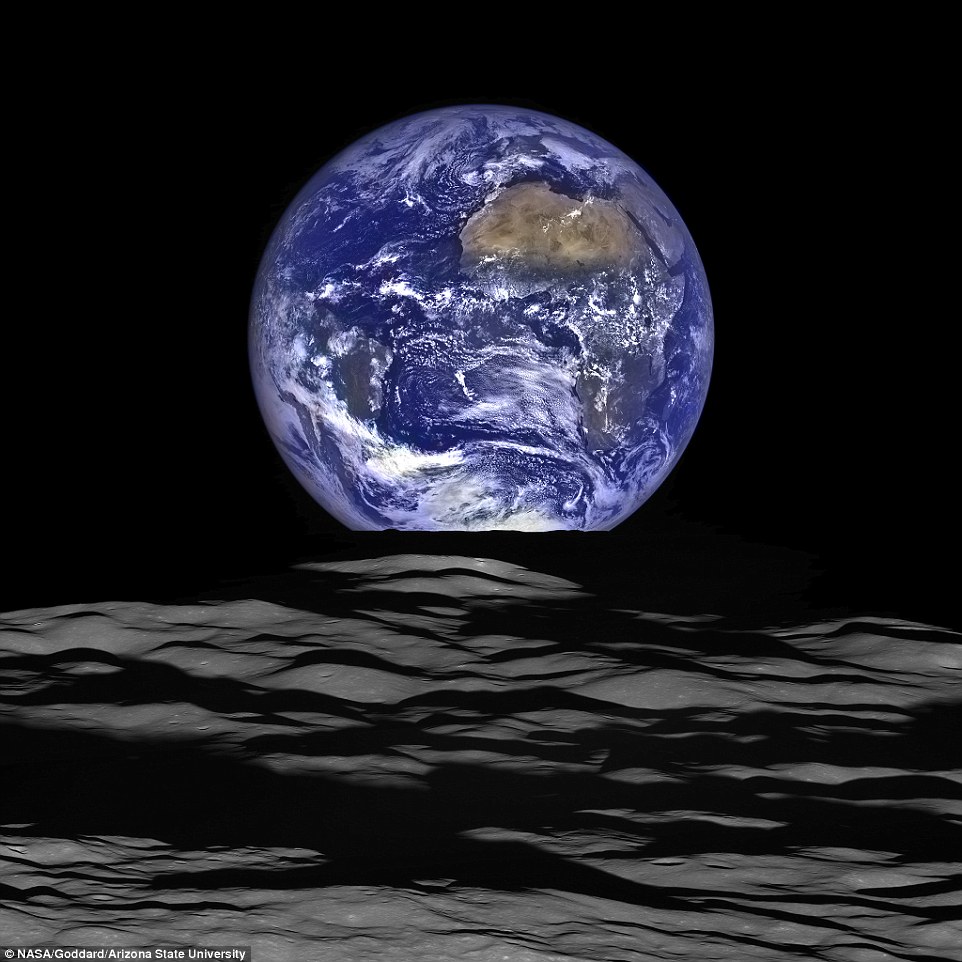
The picture of the earth was taken from a spacecraft.
Mapping: is an act of drawing the map of an area or mapping an area for study or census.
Geographic information system: Geographic information is artificial satellite (rockets) put into space to gather information.
Evaluation:
1. What is GIS System?
2. Mention some of the uses of GIS
3. What is photography?
READING ASSIGNMENT
STAN Pages 131-135 .
ASSIGNMENT
Give the meanings of the following
1. Centrifugal force
2. Weightlessness
3. Astronaut
4. Rockets
MAIN TOPIC: Satellite
SPECIFIC TOPIC: Satellite
REFERENCE BOOKS: Nigerian Basic Science Project Pupils textbook1by STAN
PERFORMANCE OBJECTIVES: At the end of the lesson the students should be able to:
a. Define satellite
b. Mention two(2) types of satellite.
CONTENT: Satellite
Satellite is a natural body that revolves round a planet. The earth is a planet and has one satellite which is the moon. Scientist has launched artificial satellite i.e. space shuttle, rockets into space to carry out experiments, collect information and learn more about the outer space.
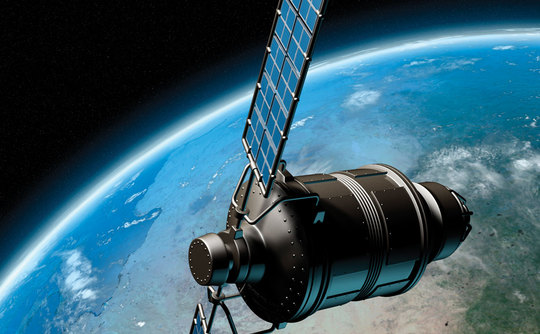
Types of satellite
Artificial satellites
Natural satellite
Artificial satellites: are the space shuttle, rockets launched into the space to carry out experiment, collect information.
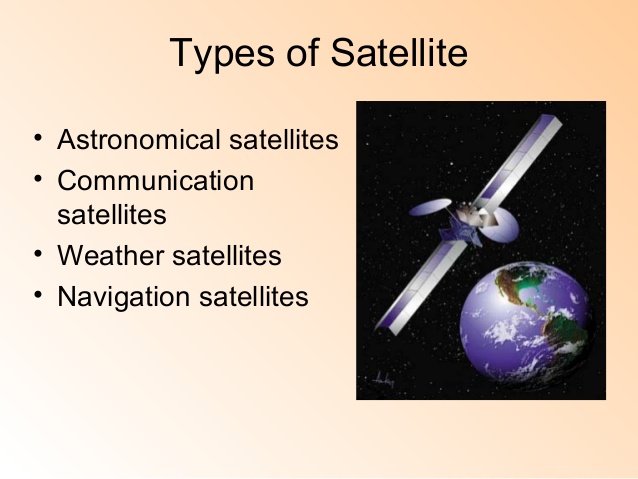
Natural satellite is the moon which revolves round a planet e.g. the earth is a planet and has one satellite.
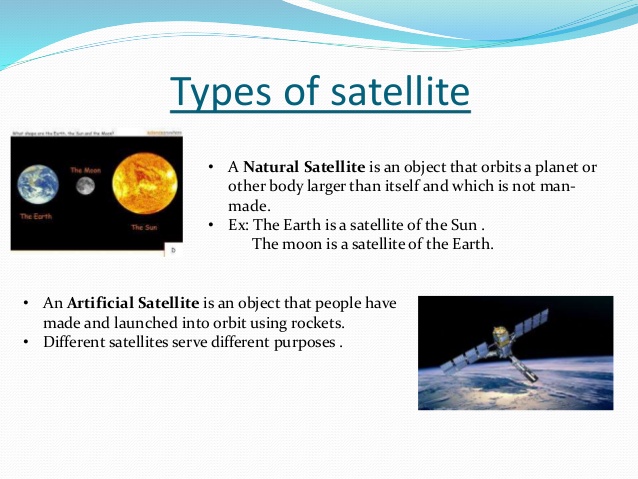
Planets in our solar system . A planets may have no, one, or more moons orbiting round it. The earth has one satellite, the moon. There are two types of satellite which are natural and artificial satellite. The natural satellite is the moon which orbit the planets in our solar system.
S/ NO........PLANETS..............No. Of moons
1...............Mercury...............None
2...............Venus.................None
3...............Earth..................1
4...............Mars...................2
5...............Jupiter...............12
6...............Saturn................9
7. .............Uranus...............5
8...............Neptune.............2
9...............Pluto..................None
Artificial satellite are the human made bodies, which were launched by various countries, and are now orbiting the earth, Artificial satellites differ from one another in the following respects.
1) Size
2) Function
3) Height of orbit around the earth
4) Shape of orbit
5) speed of revolution round the earth
6) inclination of the orbit.
When a satellite is orbiting the earth at the same speed as the earth is orbiting round the sun, to an observer on earth , that satellite will appear to be stationary.
Communication satellite are of this kind.This enables telephone or radio signals to be sent to the satellite, for a easier transmission over a large area of the earth.
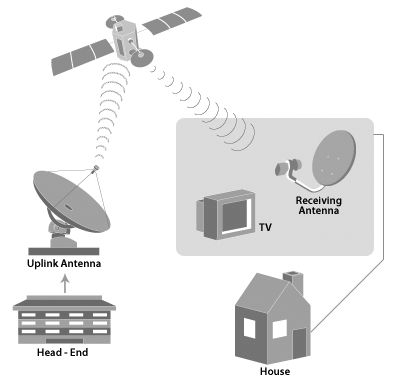
Countries which have so far launched satellites
Country.........Year of first launch.........First satellite
USSR.............1957..............................Sputnik 1
USA...............1958..............................Explorer 1
Australia.......1964............................. Blue Streak
France..........1965..............................Asterix
Japan...........1970..............................Osumi
China...........1970..............................Dong Fang Hong 1
U.Kingdom...1971..............................Prospero X 3
India............1979..............................Rohini 1
Isreal...........1988..............................Ofeg 1
Nigeria.........2003..............................SAT 1
EVALUATION:
a. Define satellites
b. Mention two(2) types of satellite
c. Explain the two types of satellite
further studies
http://www.nasa.gov/audience/forstudent ... te-58.html
http://inventors.about.com/library/inve ... ellite.htm
http://www.esa.int/esaKIDSen/SpaceStations.html
http://transition.fcc.gov/cgb/kidszone/ ... at_tv.html
http://www.esa.int/esaKIDSen/SEMICLXJD1 ... ogy_0.html
http://www.pitara.com/discover/5wh/online.asp?story=168
SUB -TOPIC : Uses of satellite
REFERENCE BK : Integrated Science for Nigerian Junior Secondary School Book 1 by F O C Ndu, L O Ndu
PERFORMANCE OBJECTIVE : At the end of the lesson student should be able to
State the uses of satellite
Explain the uses of satellite
CONTENT : USES OF SATELLITE

1) COMMUNICATION SATELLITE:-
Communication satellite are stationed in orbits for purposes of sending information quickly from one place to another. Telephone signals, for instance, can be sent from the source to the satellite. A receiver in the satellite receives the signals. A transmitter in the satellite then transmits the signals to the earth. A receiver on earth can then receive the signals from the satellite.
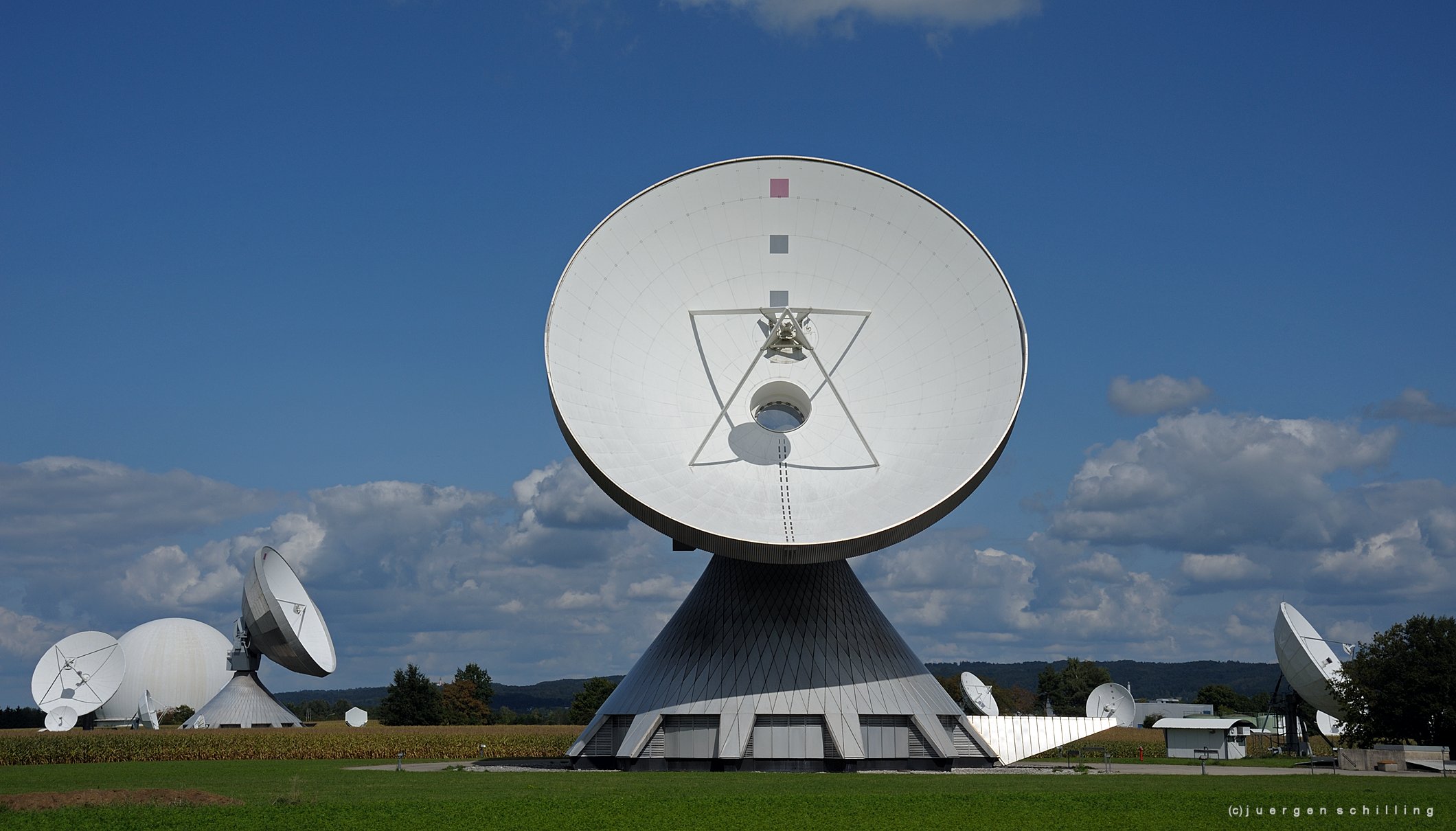
2) WEATHER SATELLITES:-
Weather satellites primarily monitor the weather conditions in the atmosphere and supply information to ground stations. This information helps weather observers to make weather forecasts.

3) OBSERVATION SATELLITES :-
Earth's observation satellites are used for military purposes such as geographical studies, photographing of areas, map making and general observation of areas of the earth.

3) RECONNAISSANCE SATELLITES :- Reconnaissance satellites are satellites used for military or intelligence purposes, such as observing enemy locations or troop movements. This satellite can catch and record radio and radar transmission when passing over any country. It can also detect missile launch and nuclear explosion. Little is known about what equipment reconnaissance satellites carry or what each satellite can do because the governments that own the satellites keep the information secret.

EVALUATION / CLASSWORK :
What are the uses of satellite
ASSIGNMENT :- Explain how artificial satellites have improved communication
further studies
http://www.stmary.ws/highschool/physics/97/MHALLETT.HTM
http://www.satellites.spacesim.org/engl ... index.html
practice test
http://www.funtrivia.com/newflash/trivia.cfm?qid=208457
http://www.funtrivia.com/playquiz/quiz2 ... de740.html
http://www.quizmoz.com/quizzes/Musician ... e-Quiz.asp
Content:
1. Meaning of satellite and Uses of satellite
2. Communication, photography, mapping etc. and GeographicalInformation System (GIS).
Sub-Topic 1: Meaning of satellite and uses:
MEANING OF SATELLITE
A satellite is a natural body revolves round a planet. As we have learned earlier, the earth has one satellite which if the moon. Scientist have launched artificial satellites (like space shuttle, rockets etc) into space to carry out experiments, collect information and learn more about other space.

Communications Satellite
Satellites floating in space have made communication over long distances easier and cheaper. A communications satellite receives a signal from Earth and then sends the information—a phone call, fax, or e-mail message—where it’s supposed to go.

Sputnik 1
The first artificial satellite was Sputnik 1, launched by the Soviet Union in 1957. It orbited Earth about once every 90 minutes for two months before it burned up in the atmosphere.


Weather Satellites
Some satellites are used to gather information about the weather. This satellite photo shows the swirling clouds of Hurricane Mitch, which hit Central America in 1998 and killed more than 11,000 people.
USES OF SATELLITE
1. To gather information
2. For photography (Taking picture of outer space)
3. For mapping
4. For finding location of mineral resources in the ground.
[youtube]https://youtu.be/54MSV2B399o[/youtube]
EVALUATION
1. What are the uses of satellite?
Sub-Topic 2: Communication, Photography, Mapping and Geographic Information System(GIS).
Communication: is an act of discussing with someone or a body in a far or near location.
Photography: It is can be carried out by the use of Photo-camera. It is an act of taking the picture of an object, man, location, town, country and earth at large.

The picture of the earth was taken from a spacecraft.
Mapping: is an act of drawing the map of an area or mapping an area for study or census.
Geographic information system: Geographic information is artificial satellite (rockets) put into space to gather information.
Evaluation:
1. What is GIS System?
2. Mention some of the uses of GIS
3. What is photography?
READING ASSIGNMENT
STAN Pages 131-135 .
ASSIGNMENT
Give the meanings of the following
1. Centrifugal force
2. Weightlessness
3. Astronaut
4. Rockets
MAIN TOPIC: Satellite
SPECIFIC TOPIC: Satellite
REFERENCE BOOKS: Nigerian Basic Science Project Pupils textbook1by STAN
PERFORMANCE OBJECTIVES: At the end of the lesson the students should be able to:
a. Define satellite
b. Mention two(2) types of satellite.
CONTENT: Satellite
Satellite is a natural body that revolves round a planet. The earth is a planet and has one satellite which is the moon. Scientist has launched artificial satellite i.e. space shuttle, rockets into space to carry out experiments, collect information and learn more about the outer space.

Types of satellite
Artificial satellites
Natural satellite
Artificial satellites: are the space shuttle, rockets launched into the space to carry out experiment, collect information.

Natural satellite is the moon which revolves round a planet e.g. the earth is a planet and has one satellite.

Planets in our solar system . A planets may have no, one, or more moons orbiting round it. The earth has one satellite, the moon. There are two types of satellite which are natural and artificial satellite. The natural satellite is the moon which orbit the planets in our solar system.
S/ NO........PLANETS..............No. Of moons
1...............Mercury...............None
2...............Venus.................None
3...............Earth..................1
4...............Mars...................2
5...............Jupiter...............12
6...............Saturn................9
7. .............Uranus...............5
8...............Neptune.............2
9...............Pluto..................None
Artificial satellite are the human made bodies, which were launched by various countries, and are now orbiting the earth, Artificial satellites differ from one another in the following respects.
1) Size
2) Function
3) Height of orbit around the earth
4) Shape of orbit
5) speed of revolution round the earth
6) inclination of the orbit.
When a satellite is orbiting the earth at the same speed as the earth is orbiting round the sun, to an observer on earth , that satellite will appear to be stationary.
Communication satellite are of this kind.This enables telephone or radio signals to be sent to the satellite, for a easier transmission over a large area of the earth.

Countries which have so far launched satellites
Country.........Year of first launch.........First satellite
USSR.............1957..............................Sputnik 1
USA...............1958..............................Explorer 1
Australia.......1964............................. Blue Streak
France..........1965..............................Asterix
Japan...........1970..............................Osumi
China...........1970..............................Dong Fang Hong 1
U.Kingdom...1971..............................Prospero X 3
India............1979..............................Rohini 1
Isreal...........1988..............................Ofeg 1
Nigeria.........2003..............................SAT 1
EVALUATION:
a. Define satellites
b. Mention two(2) types of satellite
c. Explain the two types of satellite
further studies
http://www.nasa.gov/audience/forstudent ... te-58.html
http://inventors.about.com/library/inve ... ellite.htm
http://www.esa.int/esaKIDSen/SpaceStations.html
http://transition.fcc.gov/cgb/kidszone/ ... at_tv.html
http://www.esa.int/esaKIDSen/SEMICLXJD1 ... ogy_0.html
http://www.pitara.com/discover/5wh/online.asp?story=168
SUB -TOPIC : Uses of satellite
REFERENCE BK : Integrated Science for Nigerian Junior Secondary School Book 1 by F O C Ndu, L O Ndu
PERFORMANCE OBJECTIVE : At the end of the lesson student should be able to
State the uses of satellite
Explain the uses of satellite
CONTENT : USES OF SATELLITE

1) COMMUNICATION SATELLITE:-
Communication satellite are stationed in orbits for purposes of sending information quickly from one place to another. Telephone signals, for instance, can be sent from the source to the satellite. A receiver in the satellite receives the signals. A transmitter in the satellite then transmits the signals to the earth. A receiver on earth can then receive the signals from the satellite.

2) WEATHER SATELLITES:-
Weather satellites primarily monitor the weather conditions in the atmosphere and supply information to ground stations. This information helps weather observers to make weather forecasts.

3) OBSERVATION SATELLITES :-
Earth's observation satellites are used for military purposes such as geographical studies, photographing of areas, map making and general observation of areas of the earth.

3) RECONNAISSANCE SATELLITES :- Reconnaissance satellites are satellites used for military or intelligence purposes, such as observing enemy locations or troop movements. This satellite can catch and record radio and radar transmission when passing over any country. It can also detect missile launch and nuclear explosion. Little is known about what equipment reconnaissance satellites carry or what each satellite can do because the governments that own the satellites keep the information secret.

EVALUATION / CLASSWORK :
What are the uses of satellite
ASSIGNMENT :- Explain how artificial satellites have improved communication
further studies
http://www.stmary.ws/highschool/physics/97/MHALLETT.HTM
http://www.satellites.spacesim.org/engl ... index.html
practice test
http://www.funtrivia.com/newflash/trivia.cfm?qid=208457
http://www.funtrivia.com/playquiz/quiz2 ... de740.html
http://www.quizmoz.com/quizzes/Musician ... e-Quiz.asp
WEEK 6
TOPIC: ENERGY
CONTENT: Meaning of energy
Sources of energy
Forms of energy
Sub-Topic 1: Meaning of Energy:
Energy is ability or capacity to do work. Anything thing which possesses the ability to exert a force is having energy. Energy is a measure of ability to do work and is absolutely necessary for everything including life itself.

The Sun
The Sun outshines everything else in the sky. Without the Sun, there would be no life on Earth.
Source of Energy:
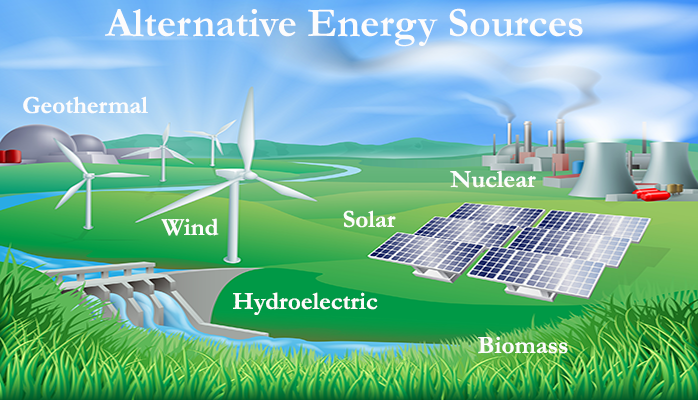
The sun or the solar system is the major source of energy. There are other natural sources
Food
Wind
Heat
Movement
Magnet, etc.
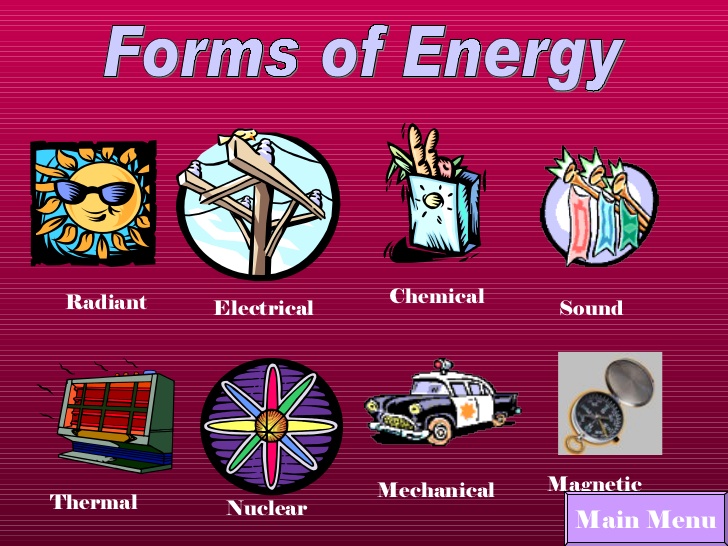
EVALUATION
1. Name the major source of energy
2. Define the word energy
Sub-Topic 2: FORMS OF ENERGY:
There are different forms of energy.
1. Chemical energy: chemical energy in man is food. Other examples of chemical energy are petrol, diesel, kerosene or coal, all these are called fuel. Fuel is chemical energy.
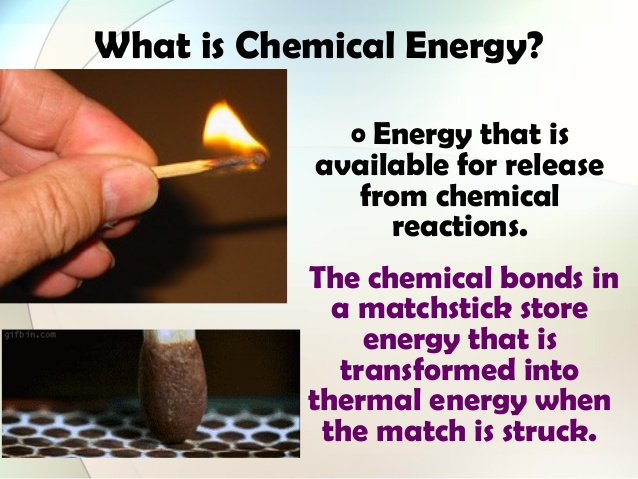
2. Mechanical energy: A person running, a car in motion, using hammer to drive a nail into wood or metal involves mechanical energy.
There are two forms of mechanical energy;
I. Kinetic or motion energy.
II. Potential or place energy.
Kinetic energy: is the type of energy possessed by a body in motion.
Potential energy: is the energy due to position of an object.

3. Electrical energy: some machines e.g. Torch, Fan, radio, television set, video, DVD player, projector etc cannot work unless they are supplied with electric current. These machines get their energy from electrical current or electricity. That mean electricity has an energy called electrical energy. Nigeria most electrical energy come from (PHCN) power generation at Kainji Dam in Kwara State.
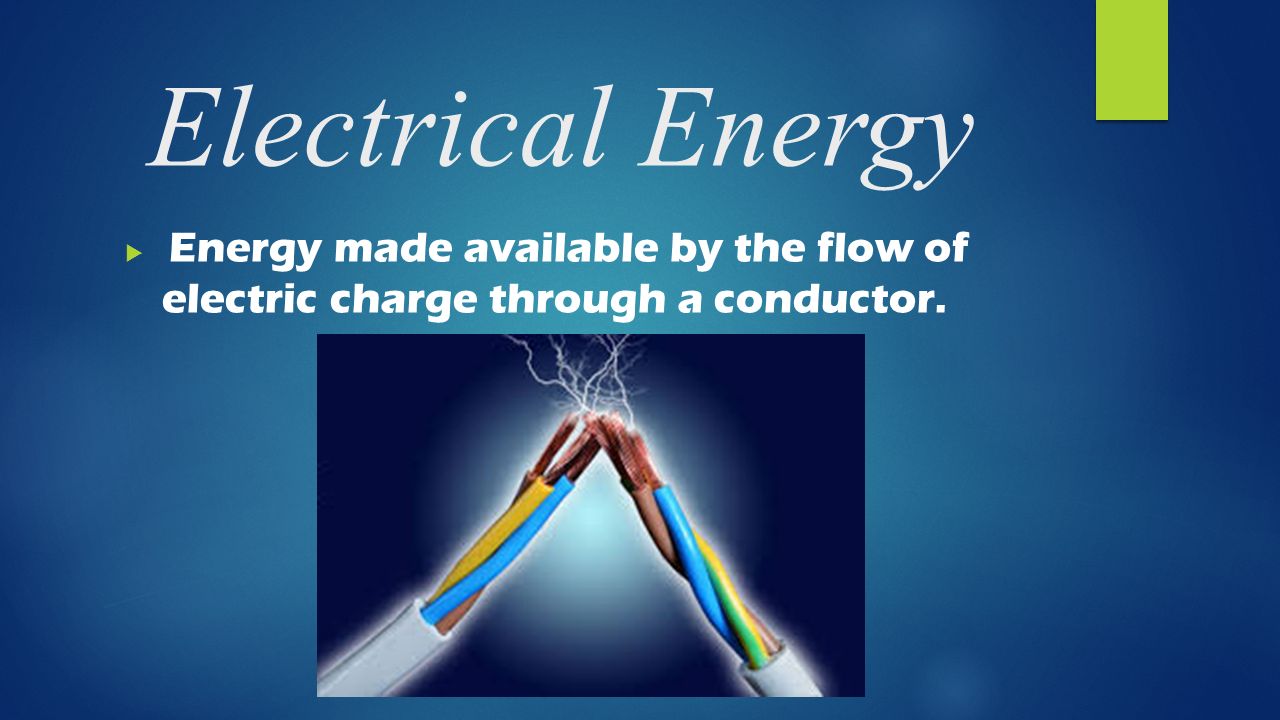
4. Heat energy: Heat carries energy from things that are hot to things that are not hot. E.g. Heat from heated ring boiler to water in a container, from stove flame to the cooking pot. Welder and Blacksmiths use heat to cut and mould metals into different shapes. Heat can be produced by burning fuels such as wood, coal, kerosene and oil. The main source of heat energy is the sun.
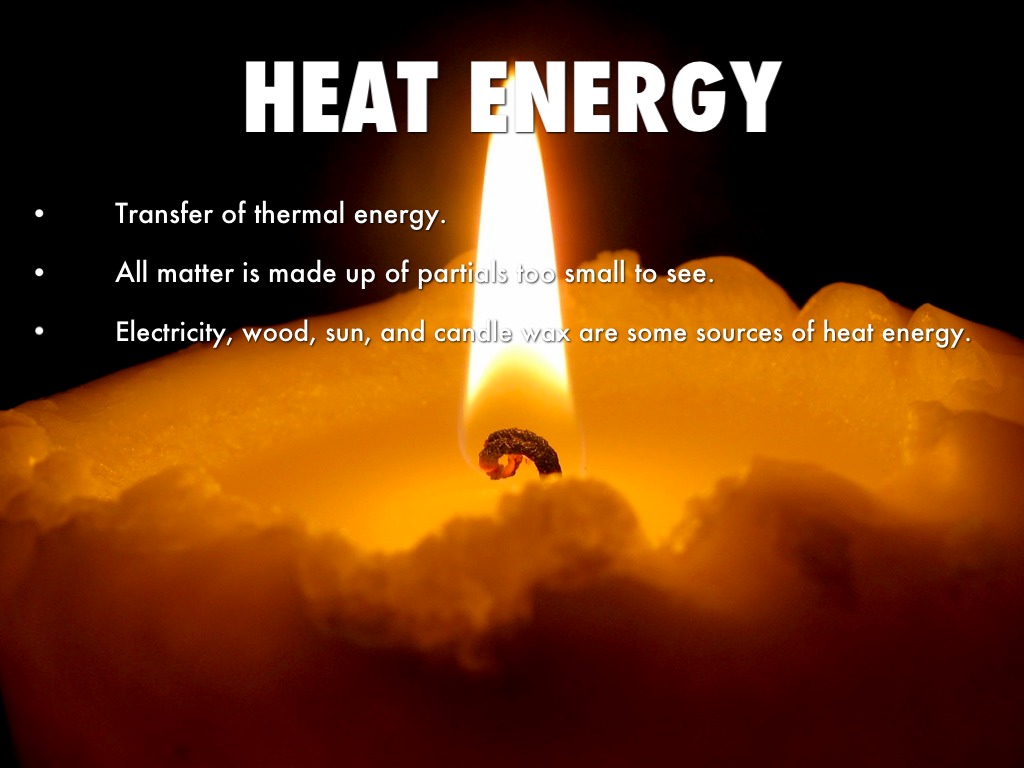
5. Light energy: light make picture of an object to register on a film thereby forming the picture. Light should have energy to be able to cause film to change when taking photograph.
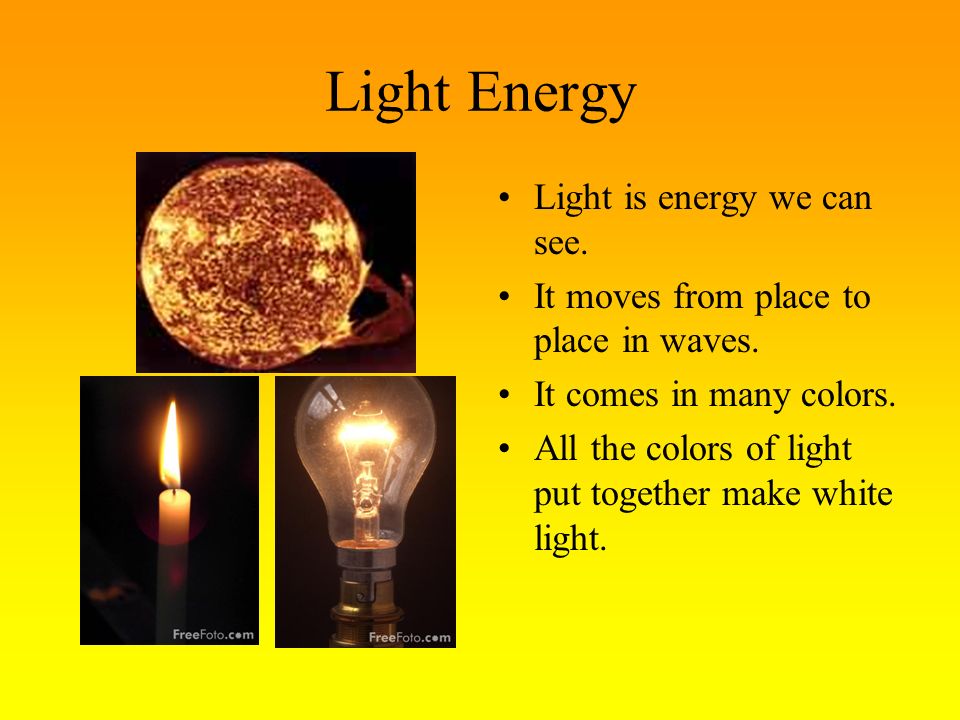

6. Sound energy: Sound is another form of energy, for example, when thunder cracks or sound, Building shakes. When a musical instrument gives a loud sound, wall cracks. That means sound give motion energy. Sound has energy.

7. Atomic Energy: All materials are made up of atoms. Atoms can be split into three namely electrons, protons and Neutrons. Protons and neutrons are bound together in an atom making up the nucleus. Breaking up this nucleus by some means release a large amount of energy. This type of energy is called atomic or nuclear energy. Atomic energy is used to generate electricity in some part of the world.
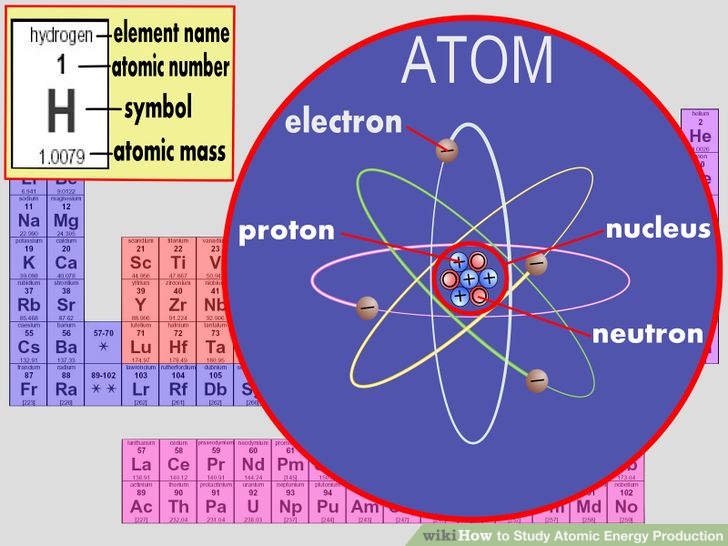
EVALUATION 1
1. State the different forms of energy.
2. Explain the meaning of atomic energy.
EVALUATION 2
1. Explain conduction.
2. Define what is meant by good and bad conductors.
3. Define convection?
4. Explain radiation
5. How does energy reach us from the sun
ASSIGNMENT
Differentiate between primary sources of energy secondary source of energy.
1. State three ways through which lack of energy supply affects societal development.
2. What are the implications of misuse of non renewable energy?
3. What type of energy has a catapult when the elastic has been pulled back.
4. Name the two forms of mechanical energy.
5. State the advantages of renewable and non-renewable energy.
READING ASSIGNMENT
STAN Pages 137-145
Further Studies 1
Further Studies 2
CONTENT: Meaning of energy
Sources of energy
Forms of energy
Sub-Topic 1: Meaning of Energy:
Energy is ability or capacity to do work. Anything thing which possesses the ability to exert a force is having energy. Energy is a measure of ability to do work and is absolutely necessary for everything including life itself.

The Sun
The Sun outshines everything else in the sky. Without the Sun, there would be no life on Earth.
Source of Energy:

The sun or the solar system is the major source of energy. There are other natural sources
Food
Wind
Heat
Movement
Magnet, etc.

EVALUATION
1. Name the major source of energy
2. Define the word energy
Sub-Topic 2: FORMS OF ENERGY:
There are different forms of energy.
1. Chemical energy: chemical energy in man is food. Other examples of chemical energy are petrol, diesel, kerosene or coal, all these are called fuel. Fuel is chemical energy.

2. Mechanical energy: A person running, a car in motion, using hammer to drive a nail into wood or metal involves mechanical energy.
There are two forms of mechanical energy;
I. Kinetic or motion energy.
II. Potential or place energy.
Kinetic energy: is the type of energy possessed by a body in motion.
Potential energy: is the energy due to position of an object.

3. Electrical energy: some machines e.g. Torch, Fan, radio, television set, video, DVD player, projector etc cannot work unless they are supplied with electric current. These machines get their energy from electrical current or electricity. That mean electricity has an energy called electrical energy. Nigeria most electrical energy come from (PHCN) power generation at Kainji Dam in Kwara State.

4. Heat energy: Heat carries energy from things that are hot to things that are not hot. E.g. Heat from heated ring boiler to water in a container, from stove flame to the cooking pot. Welder and Blacksmiths use heat to cut and mould metals into different shapes. Heat can be produced by burning fuels such as wood, coal, kerosene and oil. The main source of heat energy is the sun.

5. Light energy: light make picture of an object to register on a film thereby forming the picture. Light should have energy to be able to cause film to change when taking photograph.


6. Sound energy: Sound is another form of energy, for example, when thunder cracks or sound, Building shakes. When a musical instrument gives a loud sound, wall cracks. That means sound give motion energy. Sound has energy.

7. Atomic Energy: All materials are made up of atoms. Atoms can be split into three namely electrons, protons and Neutrons. Protons and neutrons are bound together in an atom making up the nucleus. Breaking up this nucleus by some means release a large amount of energy. This type of energy is called atomic or nuclear energy. Atomic energy is used to generate electricity in some part of the world.

EVALUATION 1
1. State the different forms of energy.
2. Explain the meaning of atomic energy.
EVALUATION 2
1. Explain conduction.
2. Define what is meant by good and bad conductors.
3. Define convection?
4. Explain radiation
5. How does energy reach us from the sun
ASSIGNMENT
Differentiate between primary sources of energy secondary source of energy.
1. State three ways through which lack of energy supply affects societal development.
2. What are the implications of misuse of non renewable energy?
3. What type of energy has a catapult when the elastic has been pulled back.
4. Name the two forms of mechanical energy.
5. State the advantages of renewable and non-renewable energy.
READING ASSIGNMENT
STAN Pages 137-145
Further Studies 1
Further Studies 2
WEEK 7
TOPIC: TRANSFER OF ENERGY
CONTENT: 1. Transfer of Energy
2. Uses of energy
Sub-Topic 1: TRANSFER OF ENERGY
Transfer of energy means how energy can be transferred from one place to another. Changing energy from one form to another is called Energy transformation .All energy transformations results to Heat energy.
TRANSFER OF ENERGY
Heat energy can move in three ways. These three ways are called conduction, convection, and radiation.
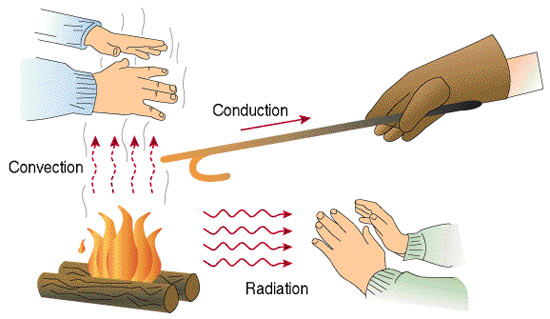
CONDUCTION: Conduction carries heat through things that are solid. The frying pan heats the bacon through conduction.The frying pan sits on a flame. Heat from the flame makes atoms at the bottom of the pan move faster. As atoms bang into other atoms, the heat energy travels from the bottom of the frying pan to the top. The heat energy enters the bacon and cooks it to a crisp.
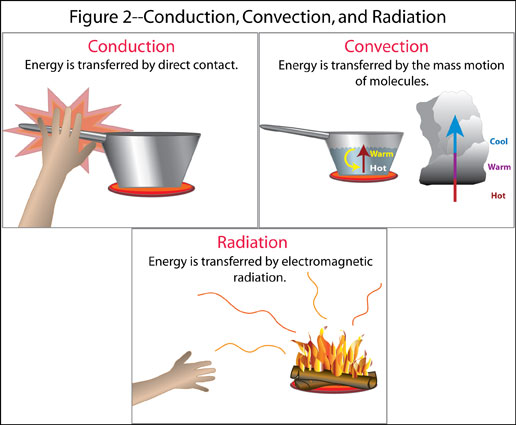
Good and bad conductors
From the above explanation we found out that heat from one end of the object was transferred to the other end without any movement of the particles of the material. This method of heat transfer (conduction) occurs mostly in metals ( solids).
Good conductors:
These are substances which conduct heat readily. All metals are good conductors of heat.
Bad conductors:
These are substances which do not conduct heat readily. Liquids and gases are bad conductors of heat. Water is an example of bad conductor.
CONVECTION: Convection heats liquids and gases. A radiator heats air in a room by convection. Air near the radiator gets hot. Hot air rises. Cooler air replaces the heated air. This air gets hot and also rises. The air keeps going around and around from cooler to hotter. The way the air moves is called convection current.
RADIATION: Radiation can send heat across empty space. This is how heat from the Sun travels to Earth. Heat rays from the Sun strike the surface of Earth and make it warm. This method of heat transfer does not involve any materials between the source of the heat and the receiver.
CHANGING POTENTIAL ENERGY TO KINETIC ENERGY
When an object rests at a point some height above the ground, the object possesses potential energy.
This is because the object is capable of doing work if free. Work must have been done on the object in taking its position. The work done is stored in the object as potential energy. As the object is set free, it falls towards the ground because of the gravitational pull on it. While falling it accelerates. That means its potential energy in its resting position changed to kinetic energy on motion. E.g. when riding a bicycle.

CHANGING CHEMICAL ENERGY TO ELECTRIC ENERGY.
Chemical energy can be converted to electrical energy in a simple cell. There are two types of cells namely wet cells and dry cell. In a wet cell you have zinc strip and carbon rod inserted in acid or base containing water while the dry cell consist of brass cap, carbon rod Manganese (IV) oxide power, ammonium chloride paste and zinc case. A very good example of dry cell is torch battery. In both cells chemical energy is converted to electrical energy.
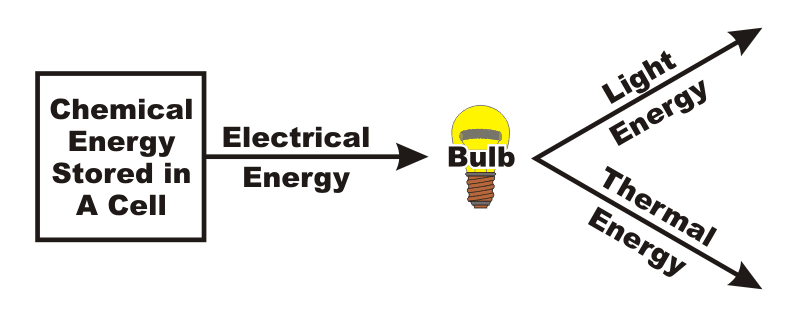
CHANGING HEAT ENERGY TO ELECTRICAL ENERGY.
When two different metals are joined together and their two junctions are kept at different temperatures, one junction becomes more highly charged with electricity than the other and the arrangement can be used to send an electric current through a circuit. When you join two different metals at two junctions, we have a thermocouple.
[youtube]https://youtu.be/CDHfDOwbHzE[/youtube]
CHANGING HEAT ENERGY TO LIGHT ENERGY.
When we heat any solid and it becomes hot, it glows. Firewood and metals glow when heated.
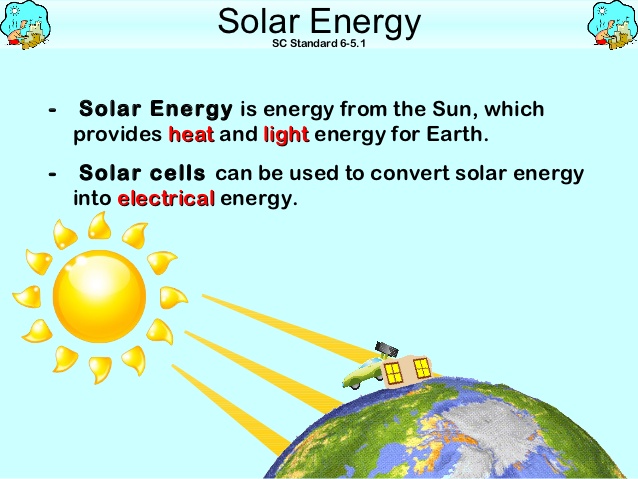
CHANGING MECHANICAL ENERGY TO ELECTRICAL ENERGY TO HEAT ENERGY.
This can be achieved by a water turbine which is just a wheel which is turned round by water coming from a tap hitting the vanes on the wheel. When the vane rotates, it produces electrical energy if connected to a light source or bulb. The rotation of the vanes is mechanical. After sometime the bulb becomes heated and hot when touched. This shows that mechanical energy has been converted to electrical and electrical to heat energy. Example of Electrical to heat energy is the pressing iron.
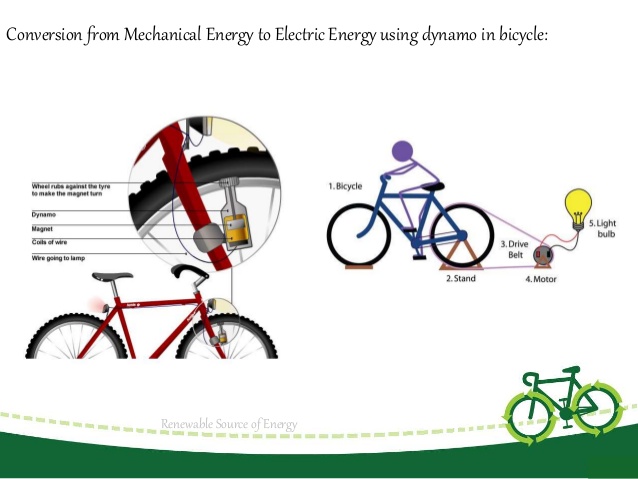
CHANGING ELECTRIC ENERGY TO MECHANICAL ENERGY TO SOUND ENERGY.
When an electric current is passed through the electric bill, the electromagnet attracts the metal strip carrying the hammer which then strikes the gong and produces sound. The attraction of the stripe breaks the circuit whereby the stripe return again to make electrical contact and the process repeats as long as current is passed through the circuit.
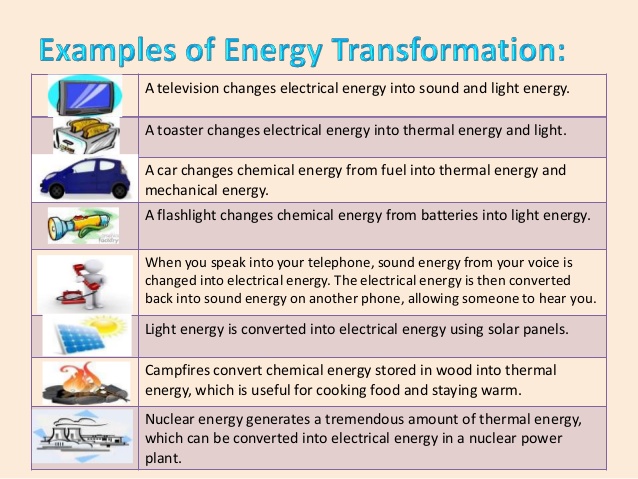
Sub-Topic: USES OF ENERGY.
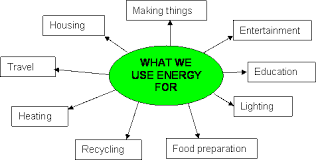
1. Electrical energy supplies Human Being with light especially at night.
2. Chemical energy supplies power to run generators, machineries and engines
3. Chemical energy supplies us chemical power to mix chemicals together to get new product and release
it.
4. Mechanical energy helps to lift heavy object.
5. Heat energy helps to cook food.
6. Sound energy enables us to hear from afar off.
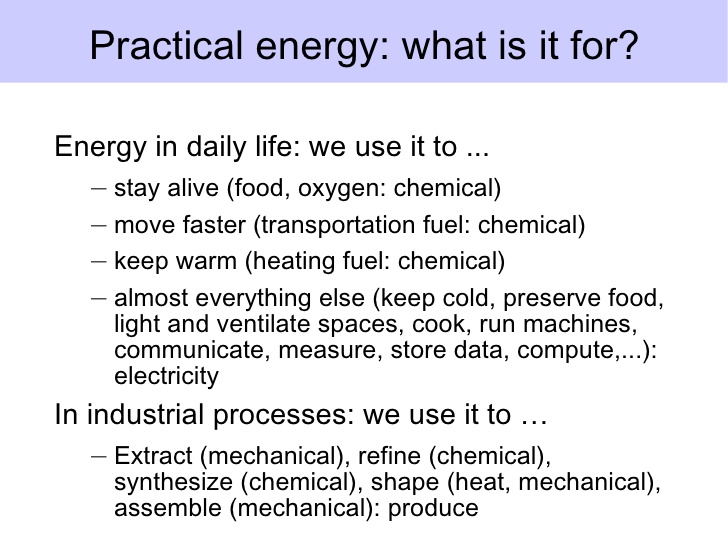
EVALUATION
1. Explain conduction and convection
2. Define what is meant by good and bad conductors.
3. Define convection?
4. List five ways energy can be transferred.
5. How does energy reach us from the sun?
READING ASSIGNMENT STAN Pages 141-145
ASSIGNMENT
What type of energy has a catapult when the elastic has been pull back.
Name the two forms of mechanical energy.
Further Studies
CONTENT: 1. Transfer of Energy
2. Uses of energy
Sub-Topic 1: TRANSFER OF ENERGY
Transfer of energy means how energy can be transferred from one place to another. Changing energy from one form to another is called Energy transformation .All energy transformations results to Heat energy.
TRANSFER OF ENERGY
Heat energy can move in three ways. These three ways are called conduction, convection, and radiation.

CONDUCTION: Conduction carries heat through things that are solid. The frying pan heats the bacon through conduction.The frying pan sits on a flame. Heat from the flame makes atoms at the bottom of the pan move faster. As atoms bang into other atoms, the heat energy travels from the bottom of the frying pan to the top. The heat energy enters the bacon and cooks it to a crisp.

Good and bad conductors
From the above explanation we found out that heat from one end of the object was transferred to the other end without any movement of the particles of the material. This method of heat transfer (conduction) occurs mostly in metals ( solids).
Good conductors:
These are substances which conduct heat readily. All metals are good conductors of heat.
Bad conductors:
These are substances which do not conduct heat readily. Liquids and gases are bad conductors of heat. Water is an example of bad conductor.
CONVECTION: Convection heats liquids and gases. A radiator heats air in a room by convection. Air near the radiator gets hot. Hot air rises. Cooler air replaces the heated air. This air gets hot and also rises. The air keeps going around and around from cooler to hotter. The way the air moves is called convection current.
RADIATION: Radiation can send heat across empty space. This is how heat from the Sun travels to Earth. Heat rays from the Sun strike the surface of Earth and make it warm. This method of heat transfer does not involve any materials between the source of the heat and the receiver.
CHANGING POTENTIAL ENERGY TO KINETIC ENERGY
When an object rests at a point some height above the ground, the object possesses potential energy.
This is because the object is capable of doing work if free. Work must have been done on the object in taking its position. The work done is stored in the object as potential energy. As the object is set free, it falls towards the ground because of the gravitational pull on it. While falling it accelerates. That means its potential energy in its resting position changed to kinetic energy on motion. E.g. when riding a bicycle.

CHANGING CHEMICAL ENERGY TO ELECTRIC ENERGY.
Chemical energy can be converted to electrical energy in a simple cell. There are two types of cells namely wet cells and dry cell. In a wet cell you have zinc strip and carbon rod inserted in acid or base containing water while the dry cell consist of brass cap, carbon rod Manganese (IV) oxide power, ammonium chloride paste and zinc case. A very good example of dry cell is torch battery. In both cells chemical energy is converted to electrical energy.

CHANGING HEAT ENERGY TO ELECTRICAL ENERGY.
When two different metals are joined together and their two junctions are kept at different temperatures, one junction becomes more highly charged with electricity than the other and the arrangement can be used to send an electric current through a circuit. When you join two different metals at two junctions, we have a thermocouple.
[youtube]https://youtu.be/CDHfDOwbHzE[/youtube]
CHANGING HEAT ENERGY TO LIGHT ENERGY.
When we heat any solid and it becomes hot, it glows. Firewood and metals glow when heated.

CHANGING MECHANICAL ENERGY TO ELECTRICAL ENERGY TO HEAT ENERGY.
This can be achieved by a water turbine which is just a wheel which is turned round by water coming from a tap hitting the vanes on the wheel. When the vane rotates, it produces electrical energy if connected to a light source or bulb. The rotation of the vanes is mechanical. After sometime the bulb becomes heated and hot when touched. This shows that mechanical energy has been converted to electrical and electrical to heat energy. Example of Electrical to heat energy is the pressing iron.

CHANGING ELECTRIC ENERGY TO MECHANICAL ENERGY TO SOUND ENERGY.
When an electric current is passed through the electric bill, the electromagnet attracts the metal strip carrying the hammer which then strikes the gong and produces sound. The attraction of the stripe breaks the circuit whereby the stripe return again to make electrical contact and the process repeats as long as current is passed through the circuit.

Sub-Topic: USES OF ENERGY.

1. Electrical energy supplies Human Being with light especially at night.
2. Chemical energy supplies power to run generators, machineries and engines
3. Chemical energy supplies us chemical power to mix chemicals together to get new product and release
it.
4. Mechanical energy helps to lift heavy object.
5. Heat energy helps to cook food.
6. Sound energy enables us to hear from afar off.

EVALUATION
1. Explain conduction and convection
2. Define what is meant by good and bad conductors.
3. Define convection?
4. List five ways energy can be transferred.
5. How does energy reach us from the sun?
READING ASSIGNMENT STAN Pages 141-145
ASSIGNMENT
What type of energy has a catapult when the elastic has been pull back.
Name the two forms of mechanical energy.
Further Studies
WEEK 8
TOPIC: RENEWABLE AND NON-RENEWABLE ENERGY
CONTENT: 1. Meaning of renewable and nonrenewable energy and
examples of renewable and nonrenewable energy.
2. Uses and misuses of renewable and non renewable energy.
SUB-TOPIC 1: MEANING OF RENEWABLE AND NON RENEWABLE ENERGY
Energy has been defined as the ability to do work. Energy is needed to carry out many or all the activities we do. Energy (petrol, gas) required to run motor vehicles, provide electricity and do many other activities in the home e.g. cooking. Some of the energy can last forever while others can last for a short period of time

RENEWABLE ENERGY: Is the energy from a source that can last forever. Examples of renewable energy are solar energy, hydroelectric dams that have generators turned by water to produce electricity (e.g. Kanji dam, Shiroro dam), wind power which is a source of energy used to run windmills to produce electricity. Wind power is not common in Nigeria as in overseas countries. Sun, wind and water will always exist and hence termed renewable energy.
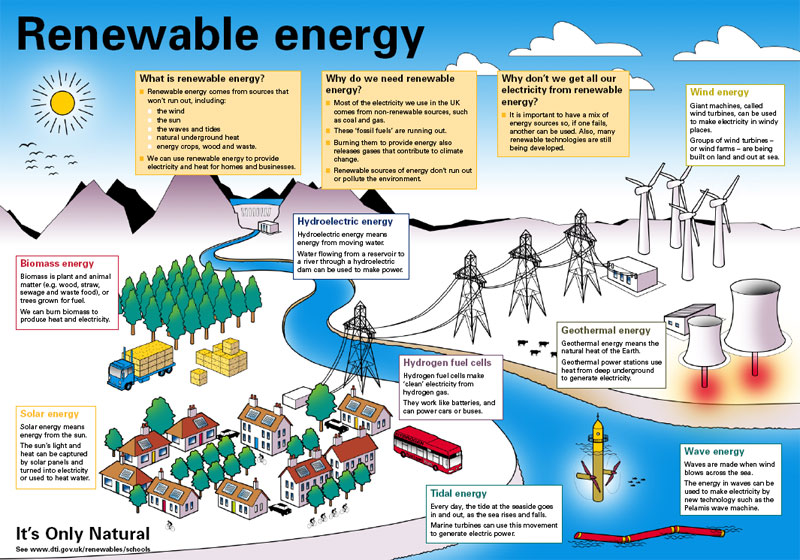
NON-RENEWABLE ENERGY:Non-renewable energy is from a source that can only last for a time. Examples of non-renewable energy are crude oil, coal, fuel, wood. Nigeria has crude oil and coal but it is said that it will only last for a period of time.
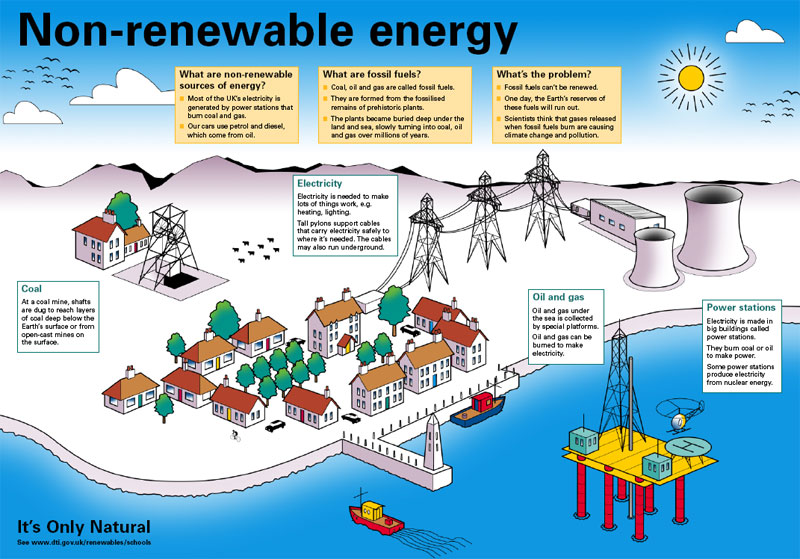
SUB-TOPIC 2: USE AND MISUSE OF RENEWABLE AND NON-RENEWABLE ENERGY.

USES
1. Renewable energy lasts a life time
2. Renewable energy is clean and does not cause pollution
3. Renewable energy is cheap once it is fully installed
MISUSE
1. Non-renewable energy does not last a life time
2. Non-renewable energy causes pollution e.g. smoke
3. Non-renewable energy is expensive e.g. cost of fuel
EVALUATION
1. Explain renewable and non-renewable energy
2. State the advantages and disadvantages of renewable and non-renewable energy.
READING ASSIGNMENT STAN Pages 144-145.
ASSIGNMENT
3. State three ways through which lack of energy supply affects societal development.
4. What are the implications of misuse of non renewable energy?
Further Studies 1
Further Studies 2
Further Studies 3
CONTENT: 1. Meaning of renewable and nonrenewable energy and
examples of renewable and nonrenewable energy.
2. Uses and misuses of renewable and non renewable energy.
SUB-TOPIC 1: MEANING OF RENEWABLE AND NON RENEWABLE ENERGY
Energy has been defined as the ability to do work. Energy is needed to carry out many or all the activities we do. Energy (petrol, gas) required to run motor vehicles, provide electricity and do many other activities in the home e.g. cooking. Some of the energy can last forever while others can last for a short period of time

RENEWABLE ENERGY: Is the energy from a source that can last forever. Examples of renewable energy are solar energy, hydroelectric dams that have generators turned by water to produce electricity (e.g. Kanji dam, Shiroro dam), wind power which is a source of energy used to run windmills to produce electricity. Wind power is not common in Nigeria as in overseas countries. Sun, wind and water will always exist and hence termed renewable energy.

NON-RENEWABLE ENERGY:Non-renewable energy is from a source that can only last for a time. Examples of non-renewable energy are crude oil, coal, fuel, wood. Nigeria has crude oil and coal but it is said that it will only last for a period of time.

SUB-TOPIC 2: USE AND MISUSE OF RENEWABLE AND NON-RENEWABLE ENERGY.

USES
1. Renewable energy lasts a life time
2. Renewable energy is clean and does not cause pollution
3. Renewable energy is cheap once it is fully installed
MISUSE
1. Non-renewable energy does not last a life time
2. Non-renewable energy causes pollution e.g. smoke
3. Non-renewable energy is expensive e.g. cost of fuel
EVALUATION
1. Explain renewable and non-renewable energy
2. State the advantages and disadvantages of renewable and non-renewable energy.
READING ASSIGNMENT STAN Pages 144-145.
ASSIGNMENT
3. State three ways through which lack of energy supply affects societal development.
4. What are the implications of misuse of non renewable energy?
Further Studies 1
Further Studies 2
Further Studies 3
WEEK 9
TOPIC: FORCES
CONTENT: Concept of force
Types of force
Sub-Topic 1: CONCEPTS OF FORCE
Force is any action that moves an object or alters it’s uniform motion in a given direction. The greater the mass of the object, the greater the force required to move it. Force is the product of mass of the objects and its acceleration. Examples of force are pull, push, tension forces and frictional force between surfaces.
.
F ά mass x acceleration
F= Kma (where K is a constant)
SUB-TOPIC: TYPES OF FORCES
There are two types of force. These are
1. Contact force
2. Force field
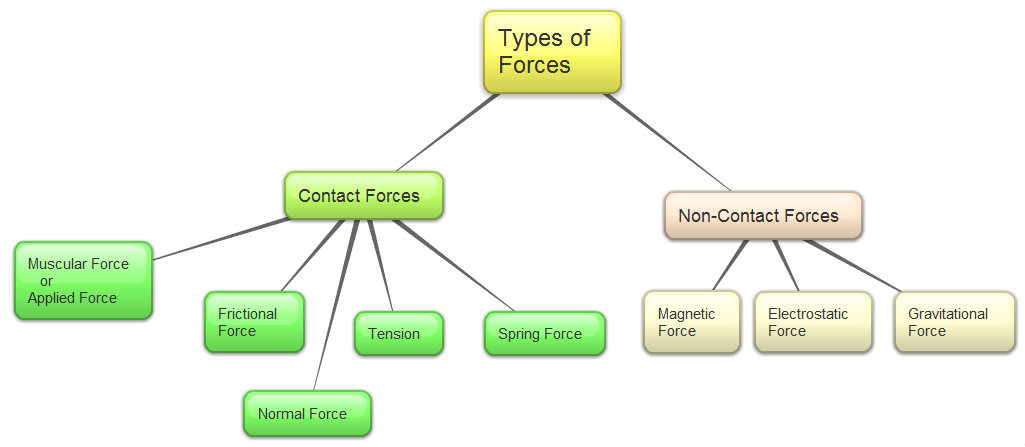
CONTACT FORCE: These are force whose sources are in contact with the body to which they are applied. This occurs between two bodies making contact with each other. The contact can be Direct or Indirect. Examples of direct contact force are push and friction while indirect contact force are pull and tension.
FRICTION:
The force that tries to stop a body from moving is called friction. The force it exerted on the moving body is called frictional force. Friction can be reduced by lubrication i.e. adding oil and grease placed between the two surfaces in contact. The oil and grease are called lubricants.

USES\ ADVANTAGES OF FRICTION
1. Without friction we cannot move and when we start moving we would not be able to stop.
2. Friction makes cars to move on the road. The tier of a car have rough surfaces so that when the engine of the car makes the wheels go round, they grip on the surface of the road. If tire and roads were so smooth there will be no friction between them, the car would not move.
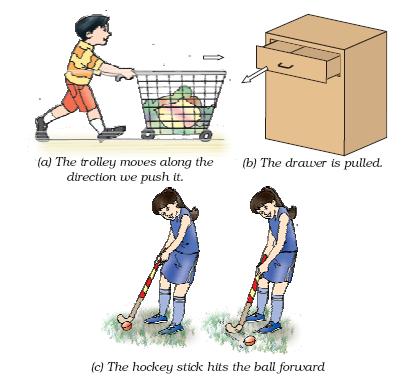
DISADVANTAGES OF FRICTIONS
1. It causes wear and tear on the moving parts of machines
2. It causes noise pollution
EVALUATION:
1. State the two types of forces with their examples.
2. Define friction and its importance
MECHANICAL ENERGY: A person running, a car in motion, using hammer to drive a nail into wood or metal involves mechanical energy.
There are two forms of mechanical energy;
I. Kinetic or motion energy.
II. Potential or place energy.
KINETIC ENERGY: Is the type of energy possessed by a body in motion.
POTENTIAL ENERGY: Is the energy due to position of an object.
FORCE FIELDS: Force field is a force whose source does not require contact with the object to which it is applied. It occurs between two bodies or objects that are separated by Space. Examples are Magnetic force, Gravitational force and Electric force.
1. MAGNETIC FORCE: This is a force that exists around magnet. Objects like iron, pin and nail are attracted by the magnetic force if brought within the magnetic field.
2. GRAVITATIONAL FORCE: Is the force with which the earth pulls all objects towards its centre. It is also called force of gravity. If a piece of stone and feather are allowed to fall at the same time, the stone reaches the ground first. This means that rate of force depend on body weight or mass.
3. ELECTRIC FORCE: This is a force that exists between two electric charges. Unlike charges attract each other. While like charges repels each other. A push (repulsive) electric force exists between either two positive charges or two negative charges.
USES OF FORCE
i. It is needed to make objects move
ii. It prevents car wheels from slipping on a tarred road when moving on it.
iii. It makes it possible for the car to stop or slow down when the brakes are applied.
iv. Friction between the sole of our feet and the ground makes it possible for us to walk without slipping.
v. Magnetic force is used by watch repairers to pick tiny iron materials like pin, and screws.
vi. Magnetic force is applied to separate iron dust from solid non-magnetic substances like Sulphur and Sand.
EVALUATION
1. What is a force field?
2. Explain with examples the two types of force field.
ASSIGNMENT
1. Explain the terms
a. Force
b. Weight
c. Charged bodies
2. State and describe an advantages of friction.
PRE-READING ASSIGNMENT
STAN Pages 153-160
MAIN TOPIC: FORCE
SPECIFIC TOPIC: Meaning of force
REFERENCE BOOK: Nigerian Basic Science Project, Pupils textbk1 by STAN pages 140-144
PERFORMANCE OBJECTIVE: At the end of the lesson the students should be able to:
a. Define force
b. State the unit of measuring power
c. Mention types of forces
CONTENT: Force
A force is any action that move or try to more an object or alters its uniform motion in a given direction. A force applied to an object can cause the object to more. The greater the mass of the object, the greater the force required to move it. Force is the product of mass of the object and its acceleration i.e.
Force = Mg Where M = Mass
= Mxg g = acceleration
The unit of force is Newton(N)
There are two types of force
a. Contact force
b. Field force

EVALUATION:
a. Define force
b. Mention the unit of force
c. Mention the types of force
ASSIGNMENT: Explain field and contact force
further studies
http://science.pppst.com/motion.html
http://www.sciencekids.co.nz/gamesactiv ... ction.html
http://www.bbc.co.uk/bitesize/ks2/scien ... processes/
LESSON 67
MAIN TOPIC: Force
SPECIFIC TOPIC: Types of force
REFERENCE BOOK
a. Nigerian Basic Science Project, Pupils textbk1 by STAN.
b. Integrated science for JSCE by Adebayo Begun.
PERFORMANCE OBJECTIVES: At the end of the lesson the students should be able to:
a. Explain the types of force
b. Solve simple calculation on force
CONTENT: Types of force
a. Contact force: This occurs between two bodies in contact with each other. Examples are pull, push, tension forces, and fractional force between surfaces. Contact force can be direct or indirect contact force.
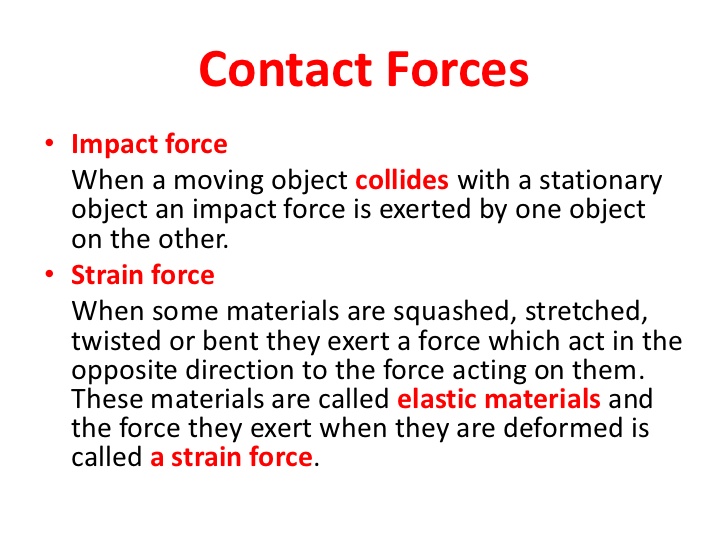

b. Field force: is a force whose source does not require contact with the object to which it is applied. It occurs between two bodies or objects separated by space. Examples are magnetic force, electric force and gravitational force.
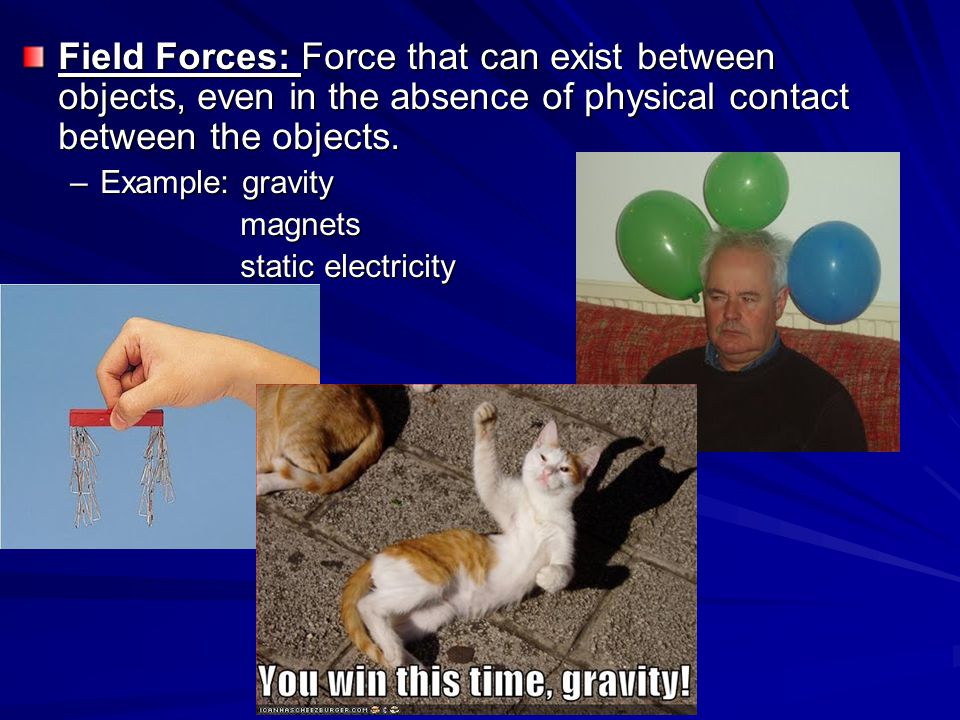
c. Magnetic force: it exits around a magnet and it is experienced by another magnetic material
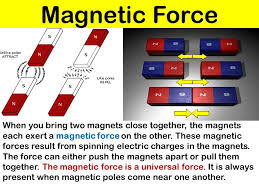
d. Gravitational force: it is in the whole region around the earth, it pull all object that goes up to the earth.


e. Electric force: is the force that exists between two electric charges
Simple calculation
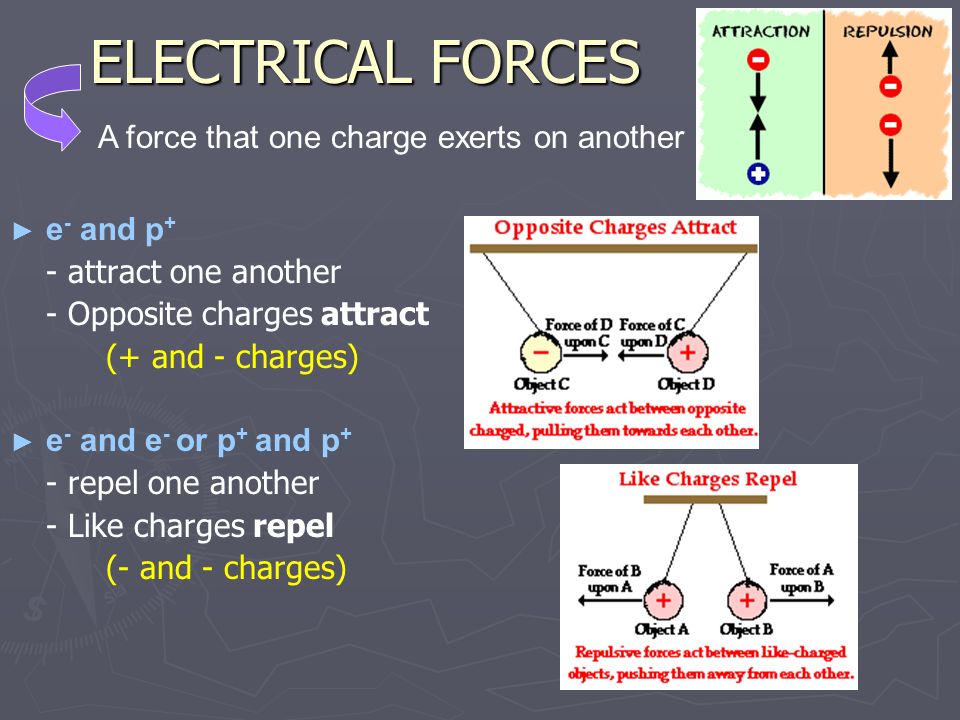
Example 1: Calculate the force on an object of mass 5kg which produces an acceleration of 4m/s-2
Solution
Force = mg :. 5 x 4 = 20N
[youtube]https://youtu.be/xCeaFWlFnk0[/youtube]
EVALUATION:
a. Mention and explain the types of forces
b. Solve the calculation: determine the force of an object of mass 20kg with an acceleration of 30m/s2
ASSIGNMENT: Calculate the force on an object of mass 500mg which produces an acceleration of 4ms2
Further Studies 1
Further Studies 2
Further Studies 3
Practice Test 1
Practice Test 2
Practice Test 3
CONTENT: Concept of force
Types of force
Sub-Topic 1: CONCEPTS OF FORCE
Force is any action that moves an object or alters it’s uniform motion in a given direction. The greater the mass of the object, the greater the force required to move it. Force is the product of mass of the objects and its acceleration. Examples of force are pull, push, tension forces and frictional force between surfaces.
.
F ά mass x acceleration
F= Kma (where K is a constant)
SUB-TOPIC: TYPES OF FORCES
There are two types of force. These are
1. Contact force
2. Force field

CONTACT FORCE: These are force whose sources are in contact with the body to which they are applied. This occurs between two bodies making contact with each other. The contact can be Direct or Indirect. Examples of direct contact force are push and friction while indirect contact force are pull and tension.
FRICTION:
The force that tries to stop a body from moving is called friction. The force it exerted on the moving body is called frictional force. Friction can be reduced by lubrication i.e. adding oil and grease placed between the two surfaces in contact. The oil and grease are called lubricants.

USES\ ADVANTAGES OF FRICTION
1. Without friction we cannot move and when we start moving we would not be able to stop.
2. Friction makes cars to move on the road. The tier of a car have rough surfaces so that when the engine of the car makes the wheels go round, they grip on the surface of the road. If tire and roads were so smooth there will be no friction between them, the car would not move.

DISADVANTAGES OF FRICTIONS
1. It causes wear and tear on the moving parts of machines
2. It causes noise pollution
EVALUATION:
1. State the two types of forces with their examples.
2. Define friction and its importance
MECHANICAL ENERGY: A person running, a car in motion, using hammer to drive a nail into wood or metal involves mechanical energy.
There are two forms of mechanical energy;
I. Kinetic or motion energy.
II. Potential or place energy.
KINETIC ENERGY: Is the type of energy possessed by a body in motion.
POTENTIAL ENERGY: Is the energy due to position of an object.
FORCE FIELDS: Force field is a force whose source does not require contact with the object to which it is applied. It occurs between two bodies or objects that are separated by Space. Examples are Magnetic force, Gravitational force and Electric force.
1. MAGNETIC FORCE: This is a force that exists around magnet. Objects like iron, pin and nail are attracted by the magnetic force if brought within the magnetic field.
2. GRAVITATIONAL FORCE: Is the force with which the earth pulls all objects towards its centre. It is also called force of gravity. If a piece of stone and feather are allowed to fall at the same time, the stone reaches the ground first. This means that rate of force depend on body weight or mass.
3. ELECTRIC FORCE: This is a force that exists between two electric charges. Unlike charges attract each other. While like charges repels each other. A push (repulsive) electric force exists between either two positive charges or two negative charges.
USES OF FORCE
i. It is needed to make objects move
ii. It prevents car wheels from slipping on a tarred road when moving on it.
iii. It makes it possible for the car to stop or slow down when the brakes are applied.
iv. Friction between the sole of our feet and the ground makes it possible for us to walk without slipping.
v. Magnetic force is used by watch repairers to pick tiny iron materials like pin, and screws.
vi. Magnetic force is applied to separate iron dust from solid non-magnetic substances like Sulphur and Sand.
EVALUATION
1. What is a force field?
2. Explain with examples the two types of force field.
ASSIGNMENT
1. Explain the terms
a. Force
b. Weight
c. Charged bodies
2. State and describe an advantages of friction.
PRE-READING ASSIGNMENT
STAN Pages 153-160
MAIN TOPIC: FORCE
SPECIFIC TOPIC: Meaning of force
REFERENCE BOOK: Nigerian Basic Science Project, Pupils textbk1 by STAN pages 140-144
PERFORMANCE OBJECTIVE: At the end of the lesson the students should be able to:
a. Define force
b. State the unit of measuring power
c. Mention types of forces
CONTENT: Force
A force is any action that move or try to more an object or alters its uniform motion in a given direction. A force applied to an object can cause the object to more. The greater the mass of the object, the greater the force required to move it. Force is the product of mass of the object and its acceleration i.e.
Force = Mg Where M = Mass
= Mxg g = acceleration
The unit of force is Newton(N)
There are two types of force
a. Contact force
b. Field force

EVALUATION:
a. Define force
b. Mention the unit of force
c. Mention the types of force
ASSIGNMENT: Explain field and contact force
further studies
http://science.pppst.com/motion.html
http://www.sciencekids.co.nz/gamesactiv ... ction.html
http://www.bbc.co.uk/bitesize/ks2/scien ... processes/
LESSON 67
MAIN TOPIC: Force
SPECIFIC TOPIC: Types of force
REFERENCE BOOK
a. Nigerian Basic Science Project, Pupils textbk1 by STAN.
b. Integrated science for JSCE by Adebayo Begun.
PERFORMANCE OBJECTIVES: At the end of the lesson the students should be able to:
a. Explain the types of force
b. Solve simple calculation on force
CONTENT: Types of force
a. Contact force: This occurs between two bodies in contact with each other. Examples are pull, push, tension forces, and fractional force between surfaces. Contact force can be direct or indirect contact force.


b. Field force: is a force whose source does not require contact with the object to which it is applied. It occurs between two bodies or objects separated by space. Examples are magnetic force, electric force and gravitational force.

c. Magnetic force: it exits around a magnet and it is experienced by another magnetic material

d. Gravitational force: it is in the whole region around the earth, it pull all object that goes up to the earth.


e. Electric force: is the force that exists between two electric charges
Simple calculation

Example 1: Calculate the force on an object of mass 5kg which produces an acceleration of 4m/s-2
Solution
Force = mg :. 5 x 4 = 20N
[youtube]https://youtu.be/xCeaFWlFnk0[/youtube]
EVALUATION:
a. Mention and explain the types of forces
b. Solve the calculation: determine the force of an object of mass 20kg with an acceleration of 30m/s2
ASSIGNMENT: Calculate the force on an object of mass 500mg which produces an acceleration of 4ms2
Further Studies 1
Further Studies 2
Further Studies 3
Practice Test 1
Practice Test 2
Practice Test 3
WEEK 10
TOPIC: Calculation on gravitational force
CONTENT: Calculation of gravitational force
Balanced and unbalanced forces
Friction
Advantages and disadvantages of friction
Sub-Topic 1: Gravitational force:
Is the force with which the earth pulls all objects towards its centre. It is also called force of gravity.
If a piece of stone and feather are allowed to fall at the same time, the stone reaches the ground first. This means that rate of force depend on body weight or mass.
Calculation of gravitational forces:
The unit of force is Newton (the symbol is N). The unit was named after Sir Isaac Newton who first discovered the facts about gravity. The weight of a body is the force the earth exerts on it. All forces are measured in Newton.
To calculate gravitational force (Gf). The following formula is used.
Gf = mgh
m = mass of the object measured in kilogram (Kg)
g = acceleration due to gravity measured in meter per seconds square (m|s2)
h = height of object measured in meter (M)
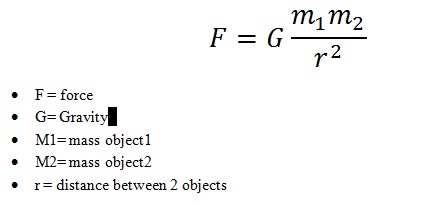
This force can be measured using a calibrated spring balance
Example:If you lift an object from the surface of the ground, you do work in opposing gravity. Suppose you lift an object of mass 2kg from the ground to height of 2m, what is the work done in lifting the object?
Solution:
The work done in lifting the object is calculated by using the formula mgh where:
W = work done = mgh
m = mass of the object in kg
g = force of gravity
h = height of object moved in meters.
g = 9.8m/s2
mgh = 2 x 2 x9.8 Newton per sec.
= 39.2Joules.
Sub-Topic 2:
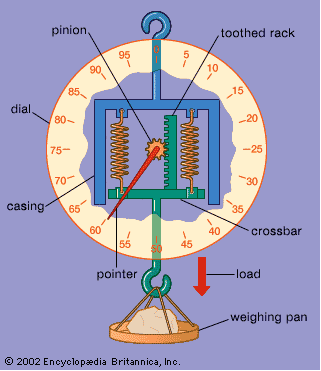
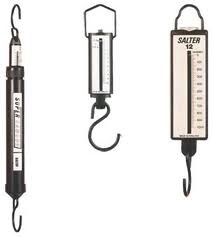
Spring balance
Distance through which the spring is pulled is a measure of the gravitational force.
F=Mg=Ke
M= mass of the object; g= acceleration due to gravity ;K= Force constant and e = extension (distance) of the spring.
Balanced and Unbalanced forces:
If a body is at rest, it means that all the forces acting upon it are equal and opposite. This is a balanced force.
But on the other hand if the forces acting on it are not equal the forces are unbalanced, the body will move in the direction of this unbalanced force.
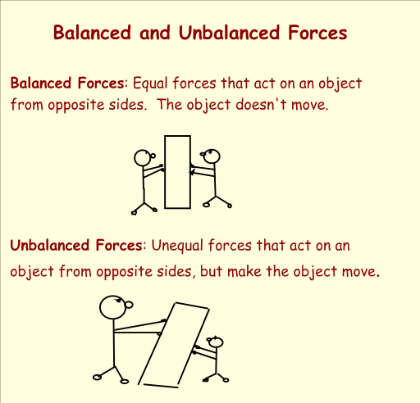
Friction:
The force that tries to stop a body from moving is called friction. The force it exerted on the moving body is called frictional force. Friction can be reduced by lubrication i.e. adding oil and grease placed between the two surfaces in contact. The oil and grease are called lubricants.

Sub-Topic 3
Uses\ advantages of friction
1. Without friction we cannot move and when we start moving we would not be able to stop.
2. Friction makes cars to move on the road. The tier of a car have rough surfaces so that when the
engine of the car makes the wheels go round, they grip on the surface of the road. If tire and roads
were so smooth there will be no friction between them, the car would not move.
Disadvantages of frictions
3. It causes wear and tear on the moving parts of machines
4. It causes unpleasant noise .
5. It increases the cost of maintenance
6. It causes heat in any engine which can lead to break down of the engine.
How to reduce friction.
Friction is reduced by application of greases and oils called Lubricants. Lubricant is placed between the two surfaces in contact
Evaluation:
1. Define friction
2. State the advantage and disadvantages of friction
3. State the formula for calculating gravitational force and explain the formula.
4. A ball of 25kg is lifted up to a height of 10meters;calculate the gravitational force using the formula G = mgh
Note: g is a constant. 9.8m/s2
Reading assignment:
Read Basic Science Made Easy pages 114-119 and STAN pages 153-160.
Assignment:
Solve the following problems;
1. Calculate the work done when an object 7kg was raised to a height 10m.
2. A ball of 25kg is lifted up to a height 12m; calculate the gravitational force
using the formula Gf = mgh. (g=9.8m\s2)
CONTENT: Calculation of gravitational force
Balanced and unbalanced forces
Friction
Advantages and disadvantages of friction
Sub-Topic 1: Gravitational force:
Is the force with which the earth pulls all objects towards its centre. It is also called force of gravity.
If a piece of stone and feather are allowed to fall at the same time, the stone reaches the ground first. This means that rate of force depend on body weight or mass.
Calculation of gravitational forces:
The unit of force is Newton (the symbol is N). The unit was named after Sir Isaac Newton who first discovered the facts about gravity. The weight of a body is the force the earth exerts on it. All forces are measured in Newton.
To calculate gravitational force (Gf). The following formula is used.
Gf = mgh
m = mass of the object measured in kilogram (Kg)
g = acceleration due to gravity measured in meter per seconds square (m|s2)
h = height of object measured in meter (M)

This force can be measured using a calibrated spring balance
Example:If you lift an object from the surface of the ground, you do work in opposing gravity. Suppose you lift an object of mass 2kg from the ground to height of 2m, what is the work done in lifting the object?
Solution:
The work done in lifting the object is calculated by using the formula mgh where:
W = work done = mgh
m = mass of the object in kg
g = force of gravity
h = height of object moved in meters.
g = 9.8m/s2
mgh = 2 x 2 x9.8 Newton per sec.
= 39.2Joules.
Sub-Topic 2:


Spring balance
Distance through which the spring is pulled is a measure of the gravitational force.
F=Mg=Ke
M= mass of the object; g= acceleration due to gravity ;K= Force constant and e = extension (distance) of the spring.
Balanced and Unbalanced forces:
If a body is at rest, it means that all the forces acting upon it are equal and opposite. This is a balanced force.
But on the other hand if the forces acting on it are not equal the forces are unbalanced, the body will move in the direction of this unbalanced force.

Friction:
The force that tries to stop a body from moving is called friction. The force it exerted on the moving body is called frictional force. Friction can be reduced by lubrication i.e. adding oil and grease placed between the two surfaces in contact. The oil and grease are called lubricants.

Sub-Topic 3
Uses\ advantages of friction
1. Without friction we cannot move and when we start moving we would not be able to stop.
2. Friction makes cars to move on the road. The tier of a car have rough surfaces so that when the
engine of the car makes the wheels go round, they grip on the surface of the road. If tire and roads
were so smooth there will be no friction between them, the car would not move.
Disadvantages of frictions
3. It causes wear and tear on the moving parts of machines
4. It causes unpleasant noise .
5. It increases the cost of maintenance
6. It causes heat in any engine which can lead to break down of the engine.
How to reduce friction.
Friction is reduced by application of greases and oils called Lubricants. Lubricant is placed between the two surfaces in contact
Evaluation:
1. Define friction
2. State the advantage and disadvantages of friction
3. State the formula for calculating gravitational force and explain the formula.
4. A ball of 25kg is lifted up to a height of 10meters;calculate the gravitational force using the formula G = mgh
Note: g is a constant. 9.8m/s2
Reading assignment:
Read Basic Science Made Easy pages 114-119 and STAN pages 153-160.
Assignment:
Solve the following problems;
1. Calculate the work done when an object 7kg was raised to a height 10m.
2. A ball of 25kg is lifted up to a height 12m; calculate the gravitational force
using the formula Gf = mgh. (g=9.8m\s2)
